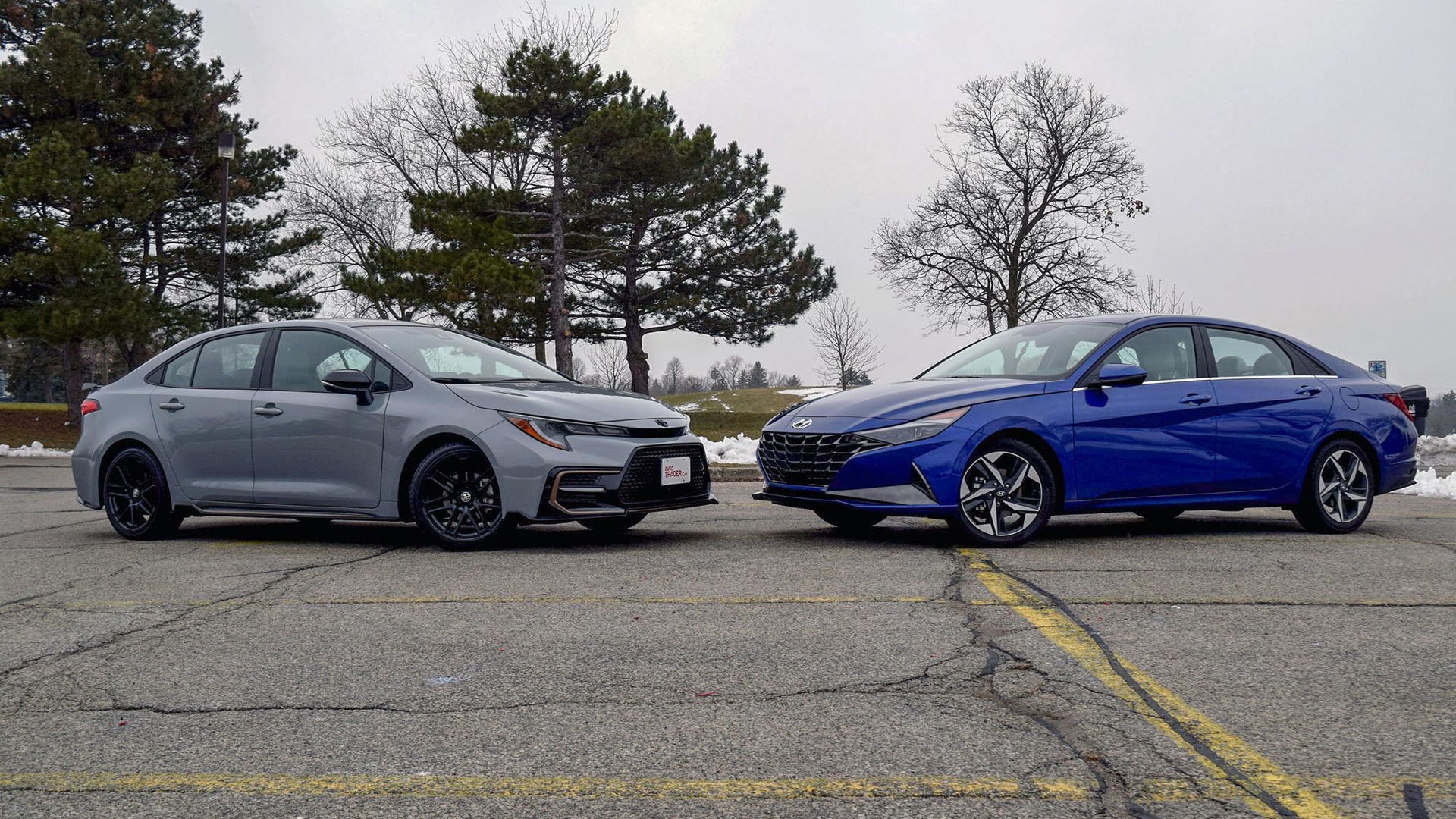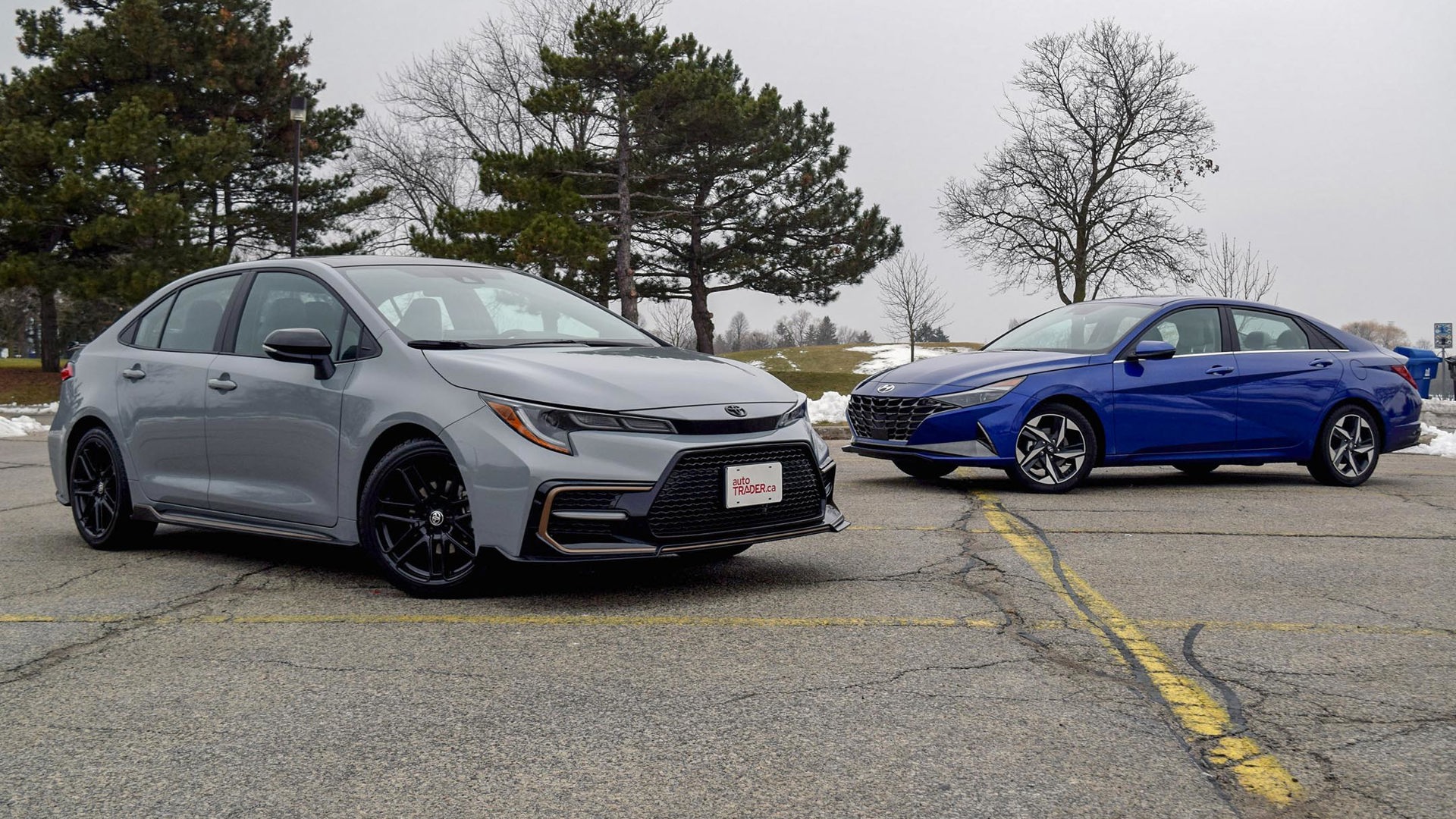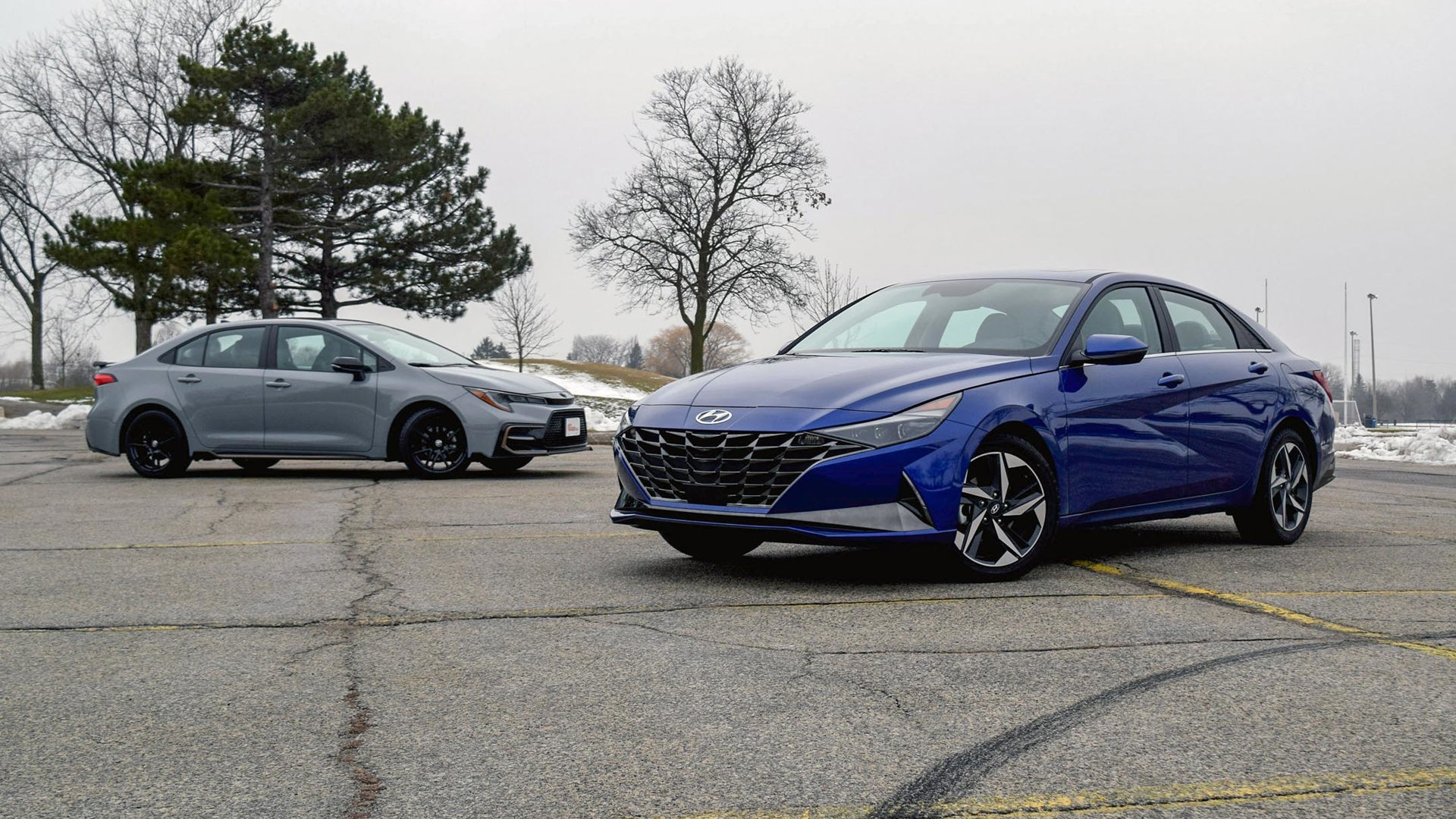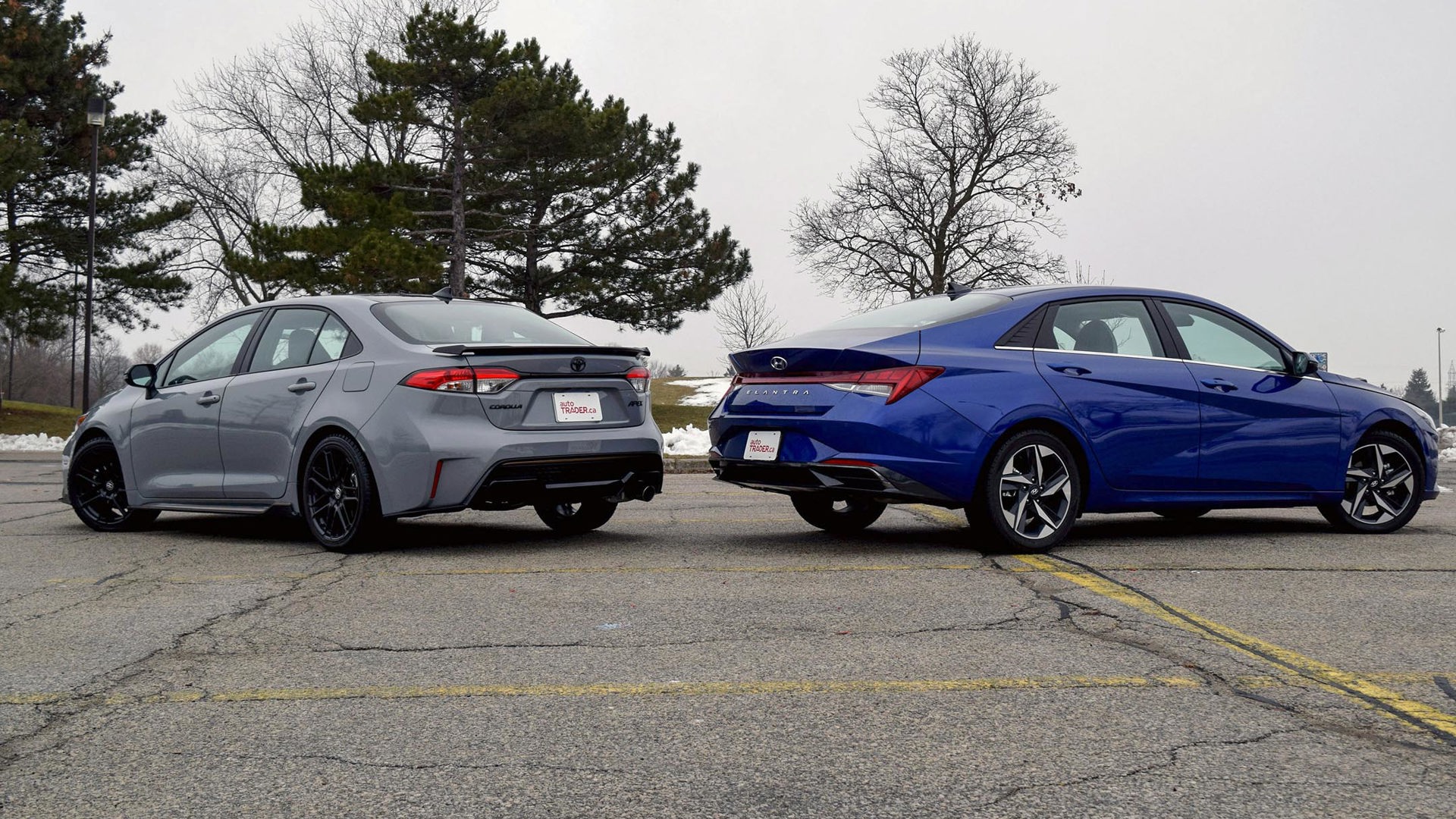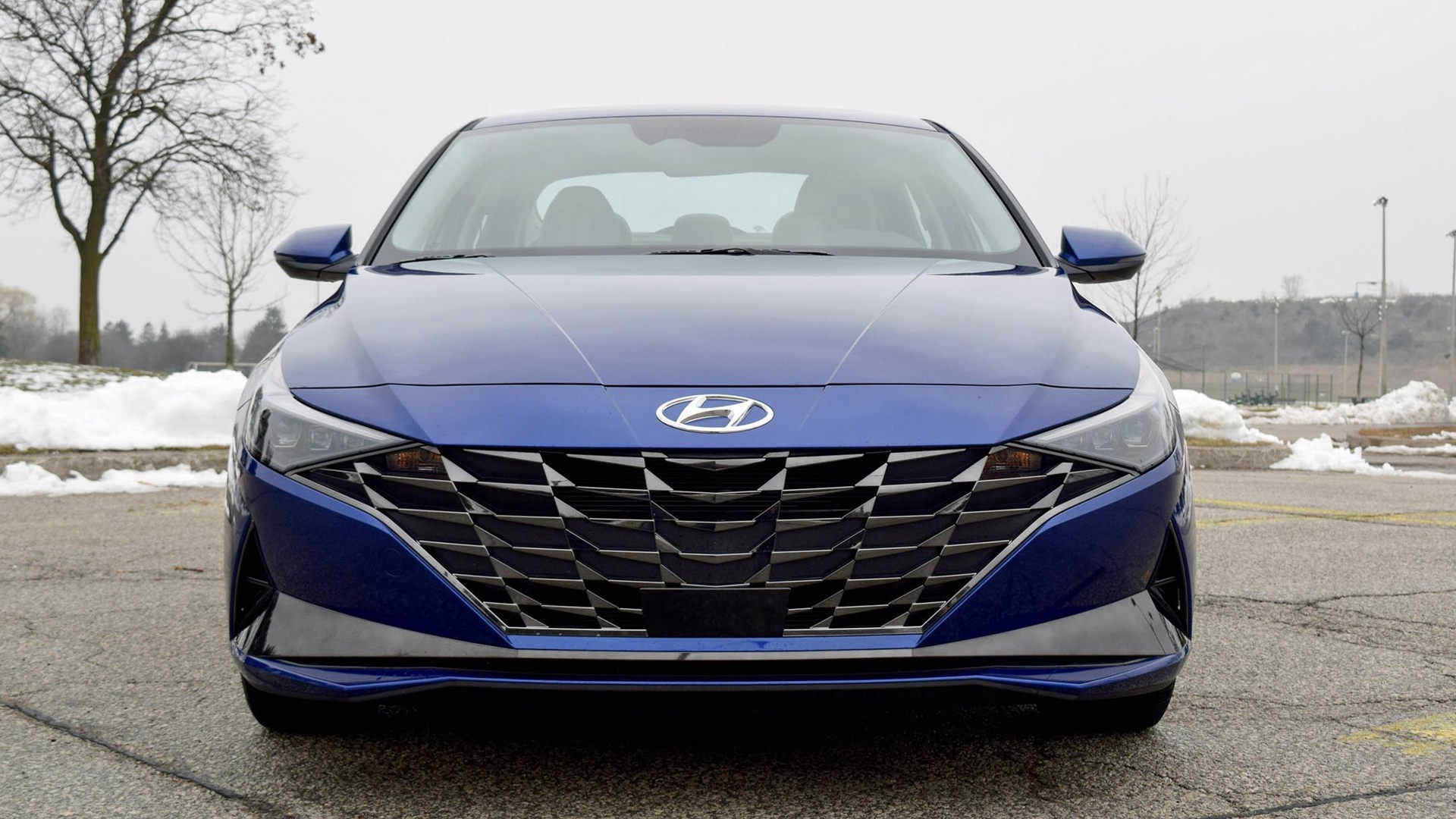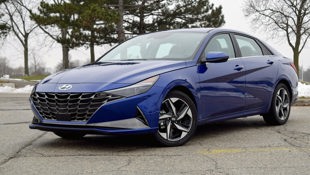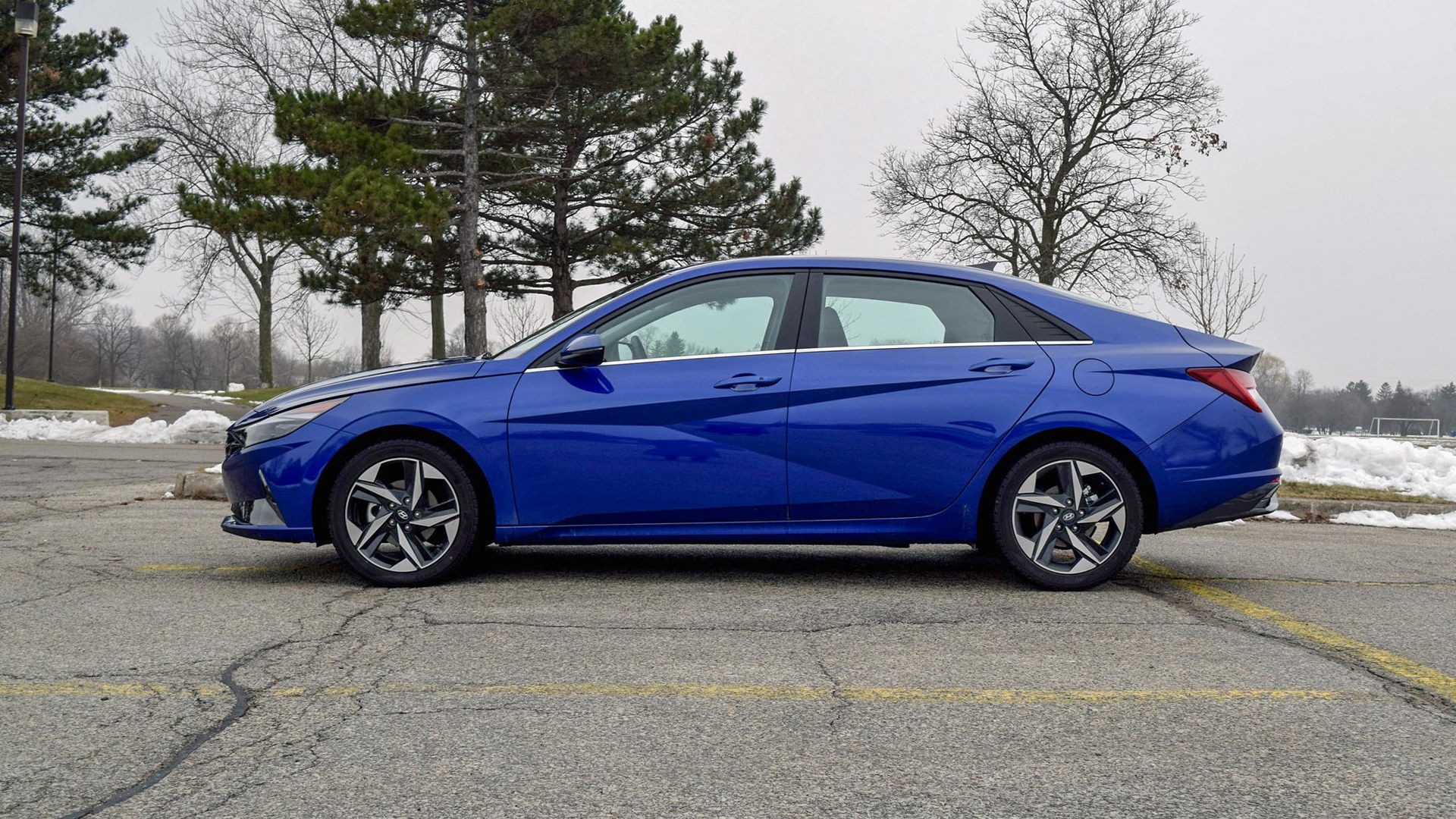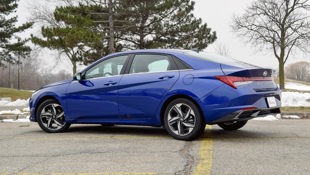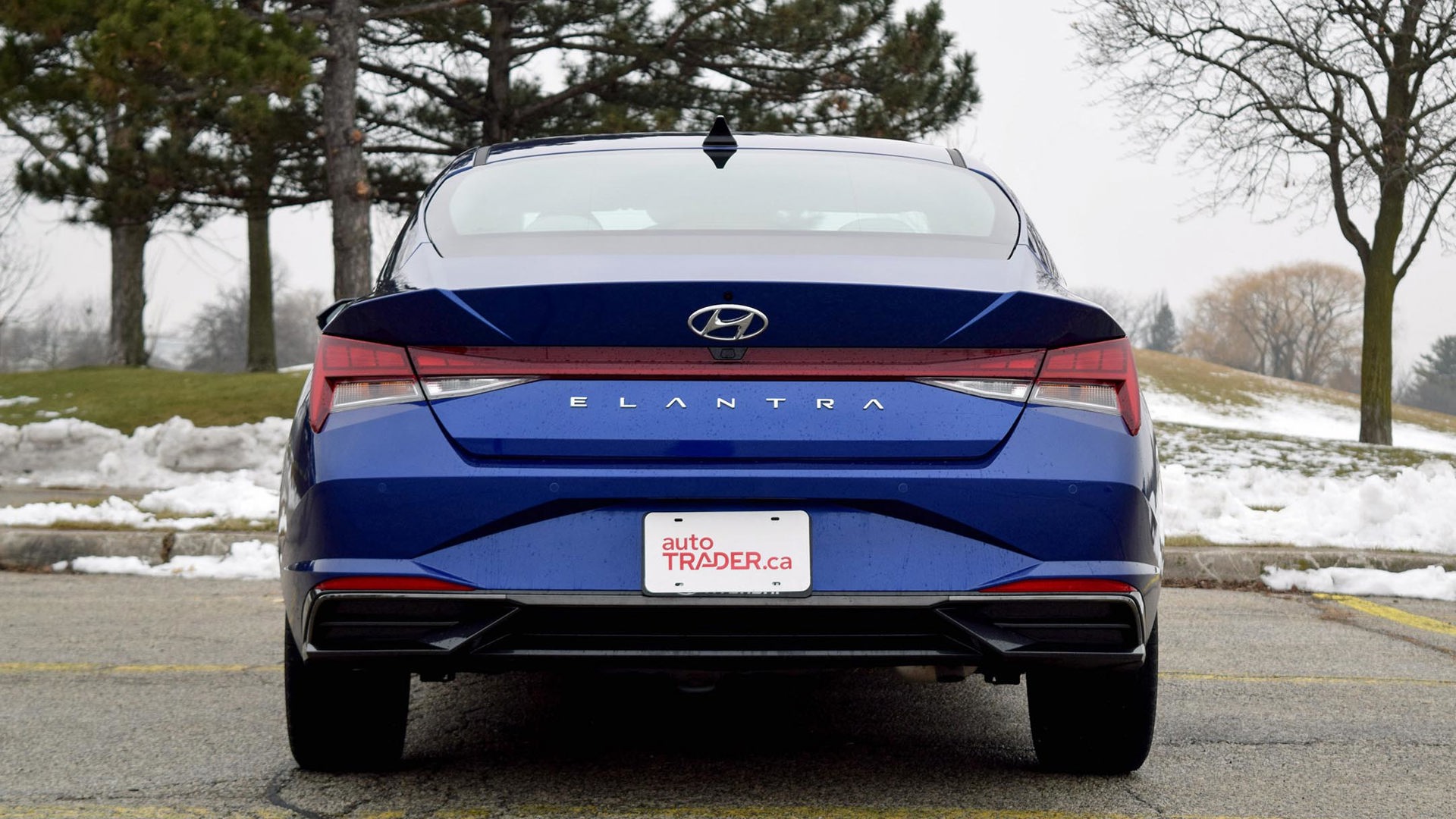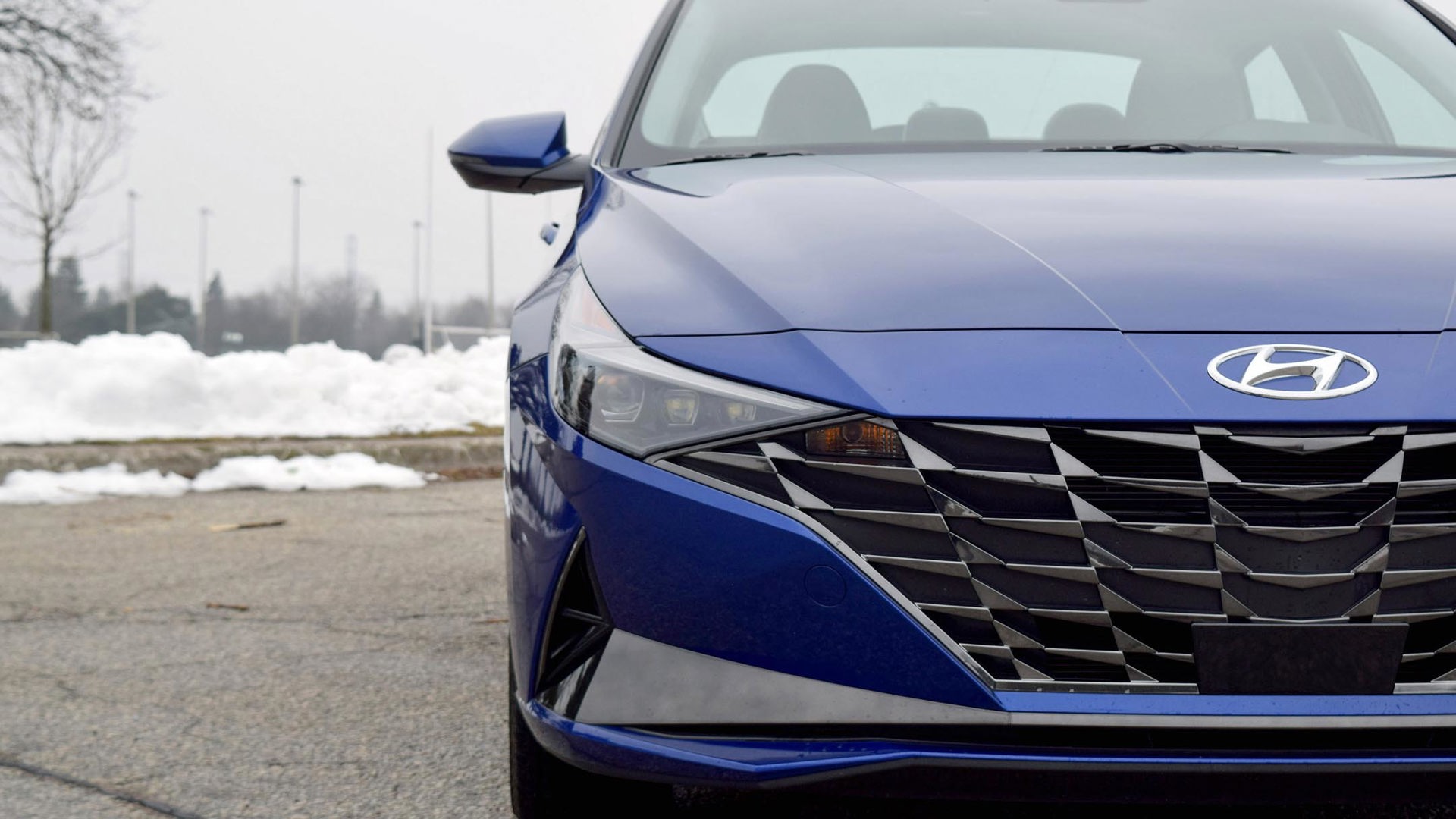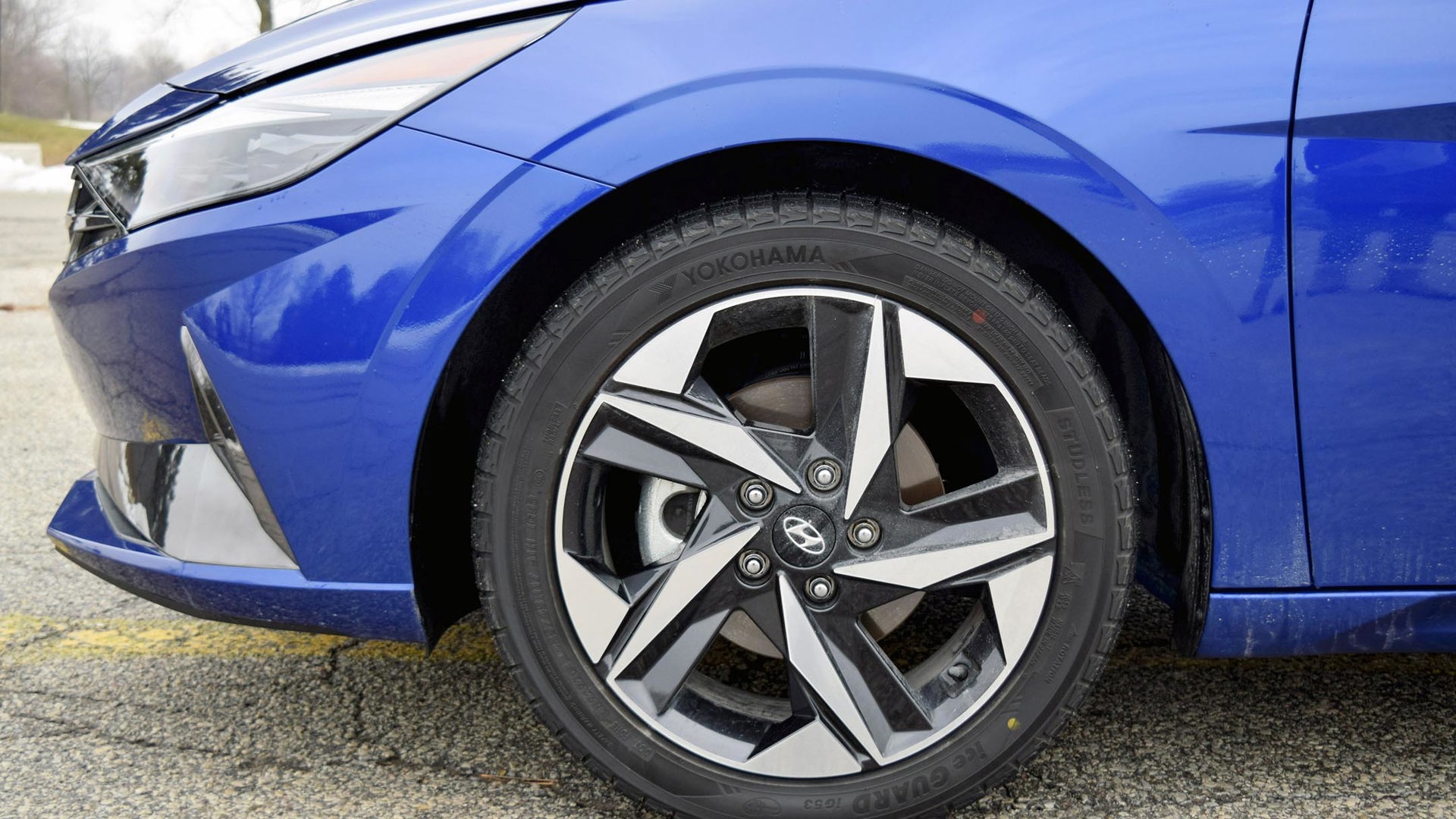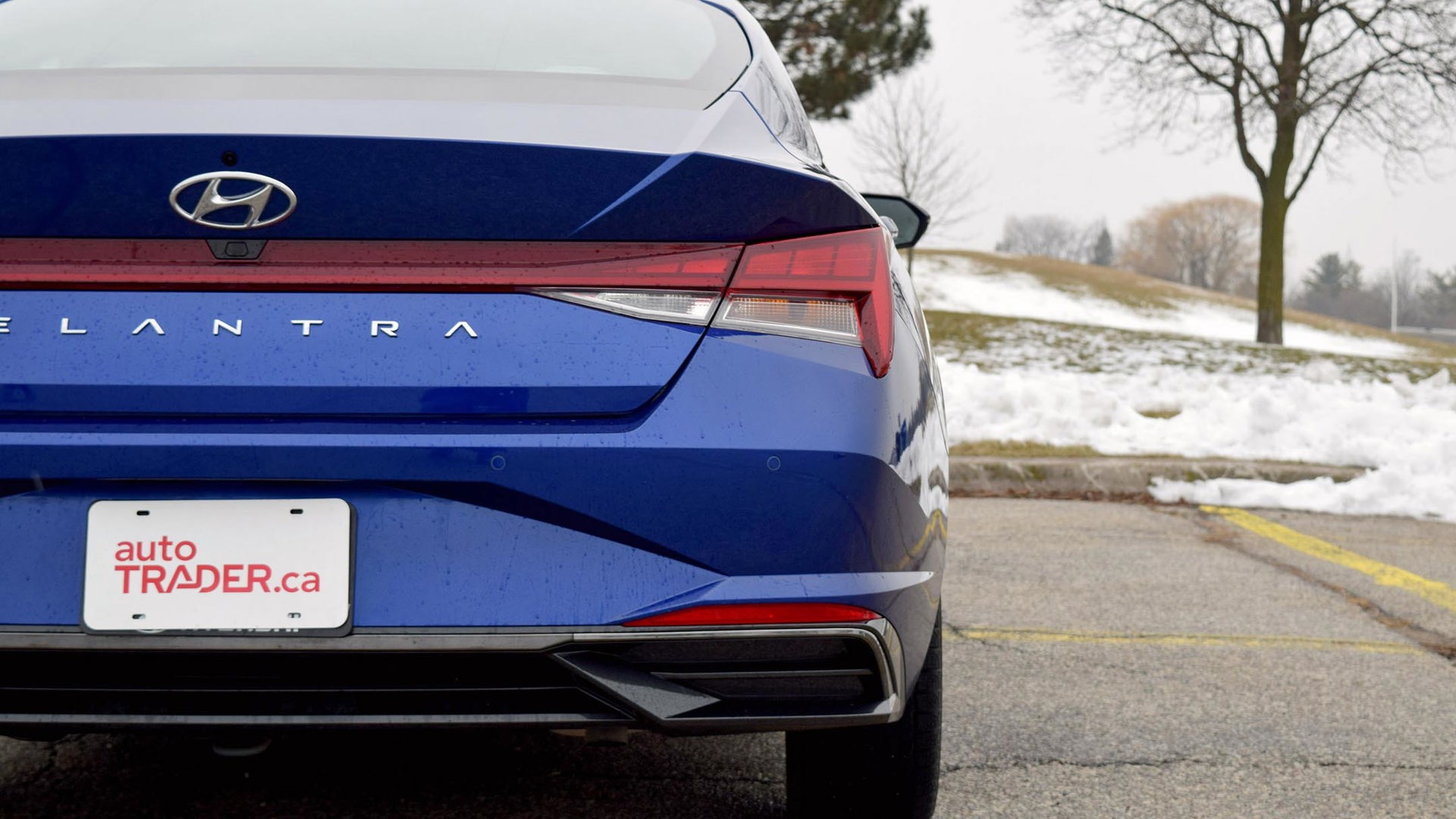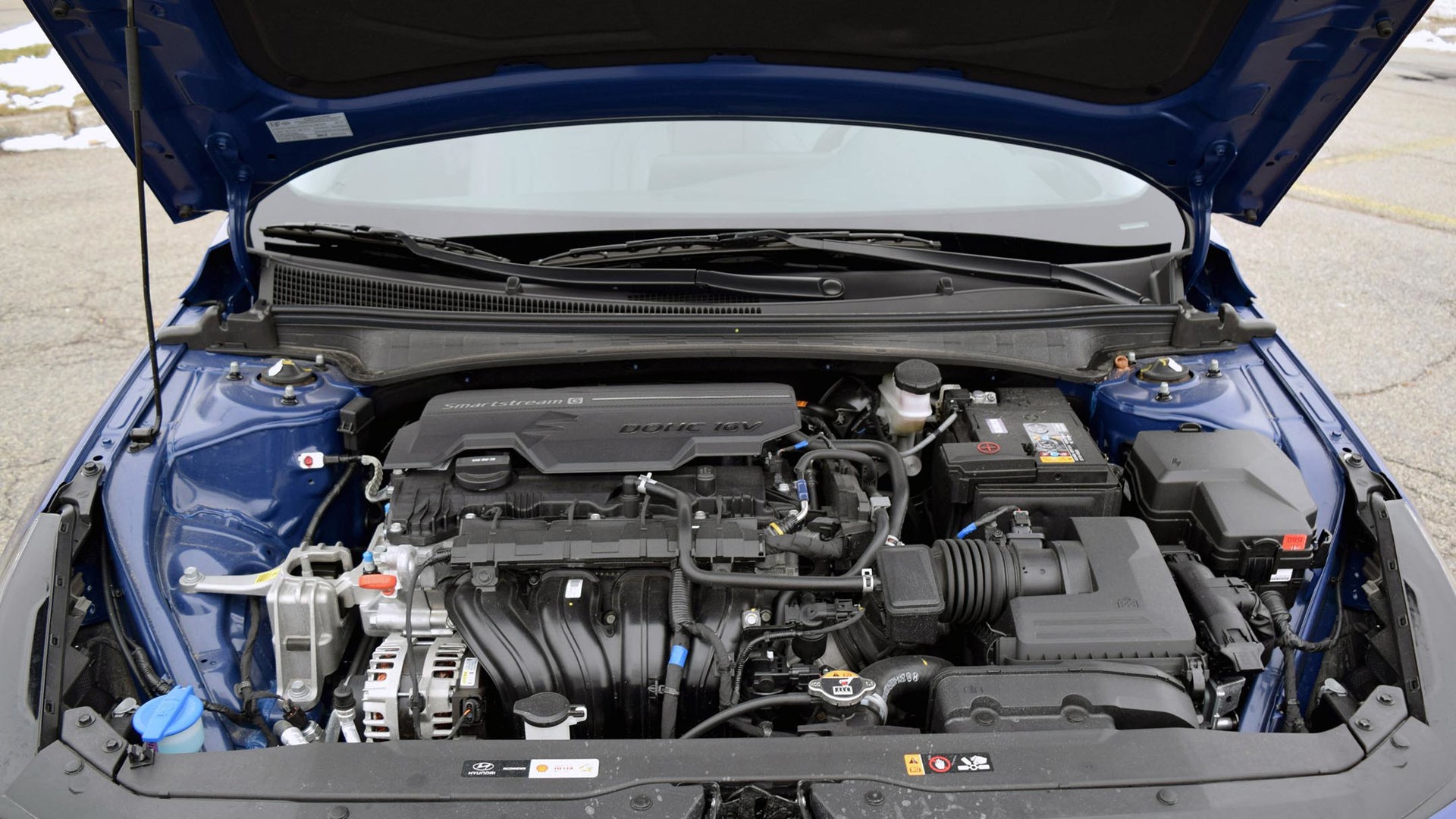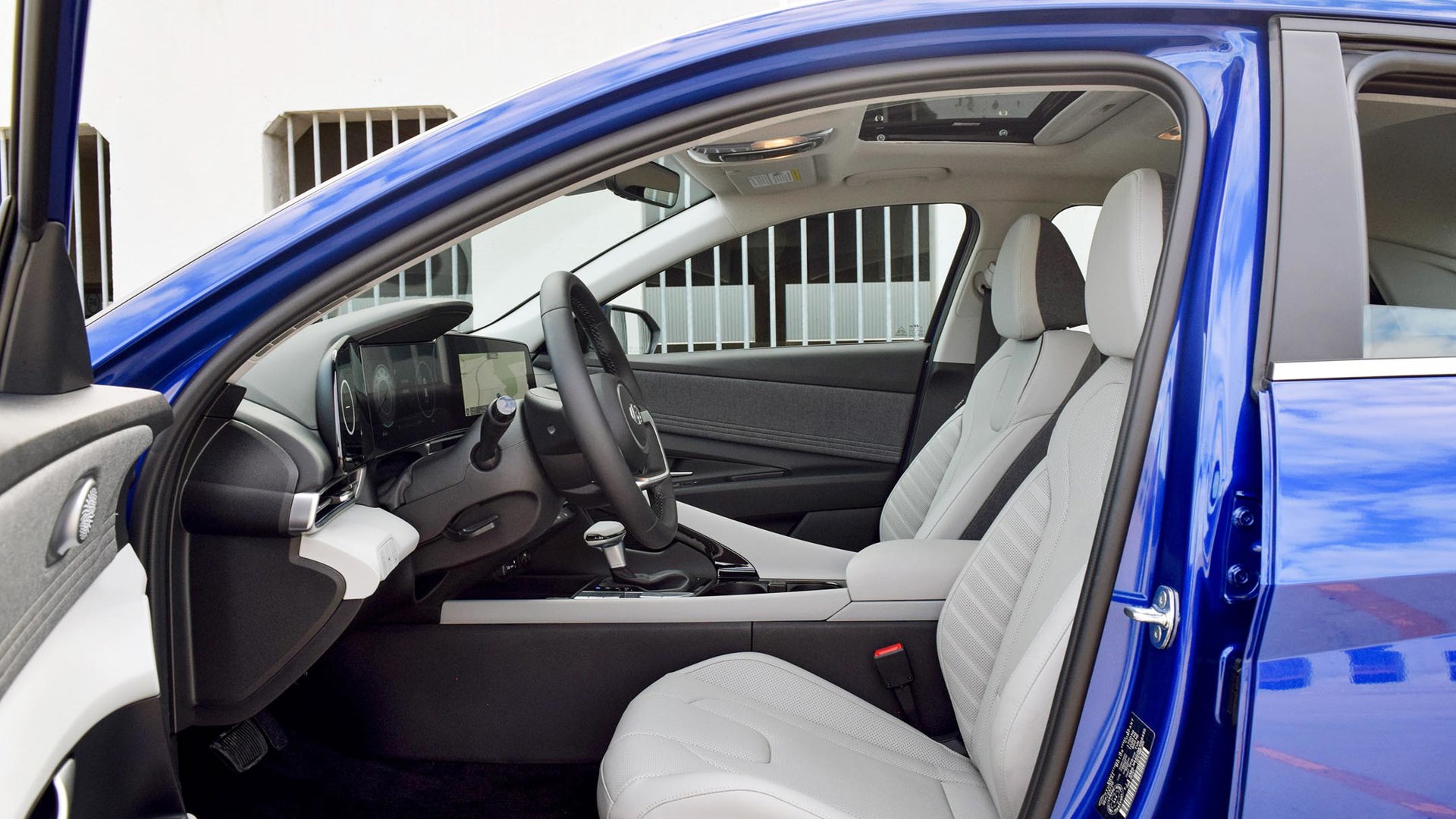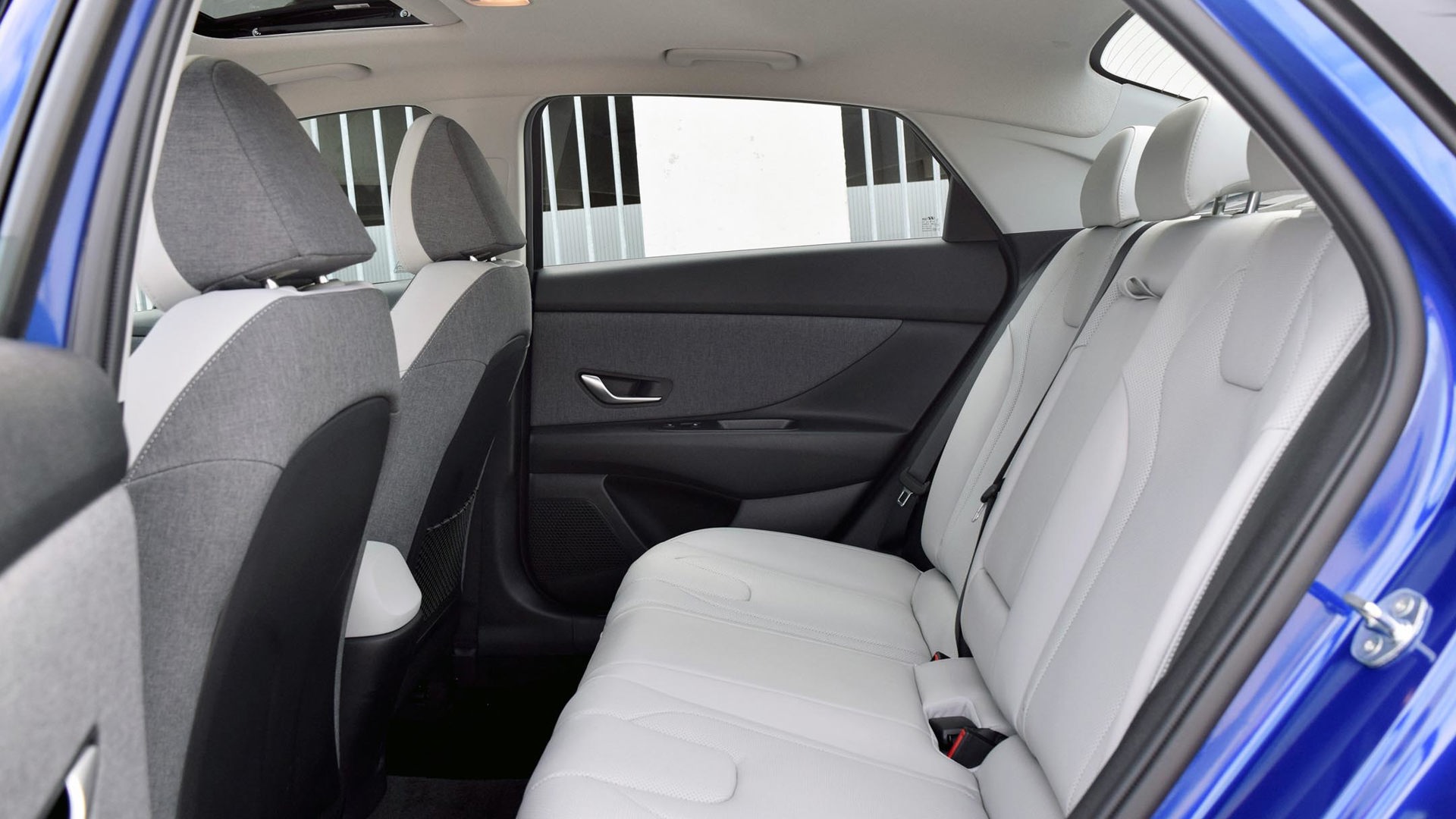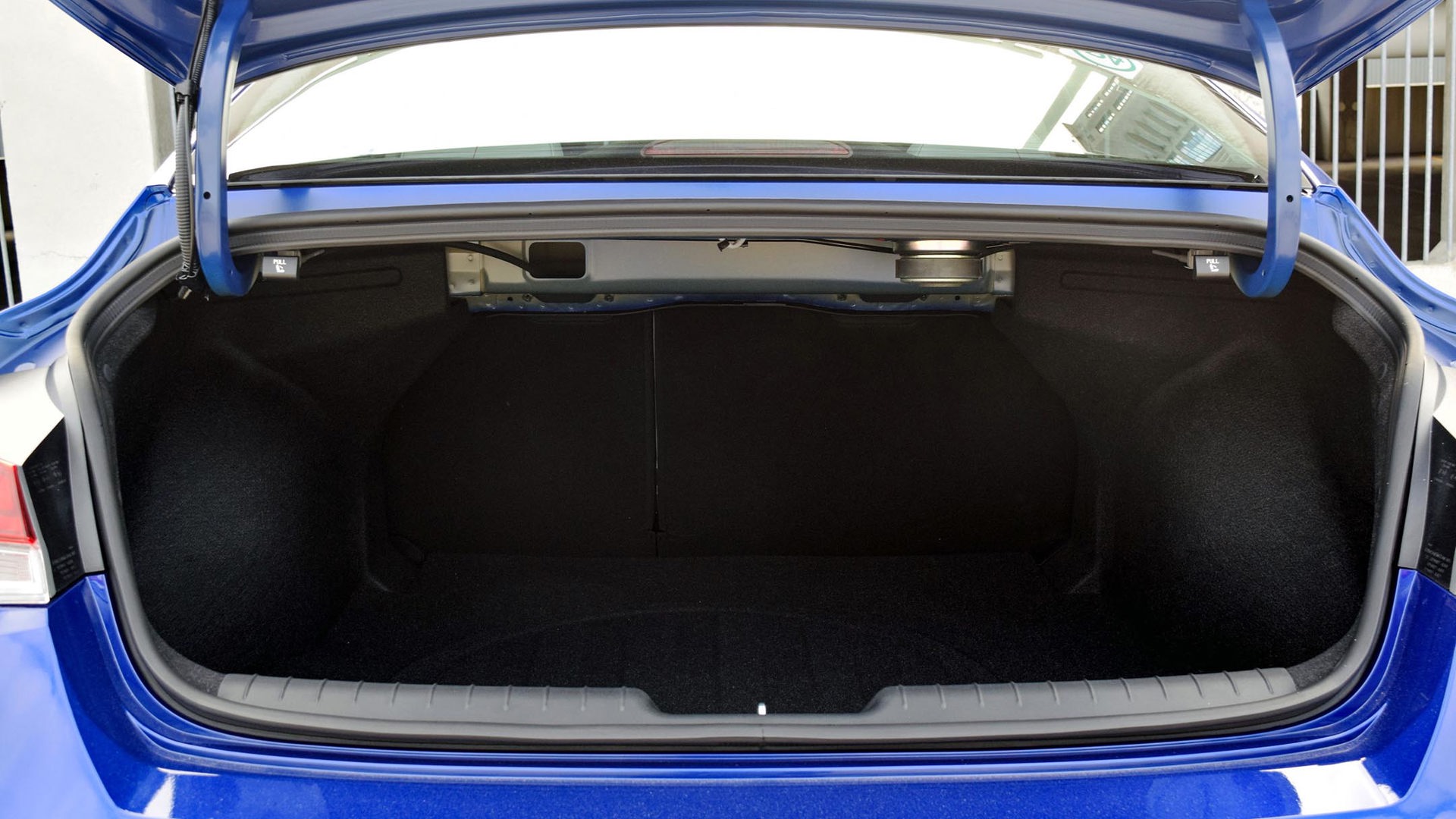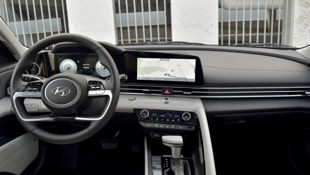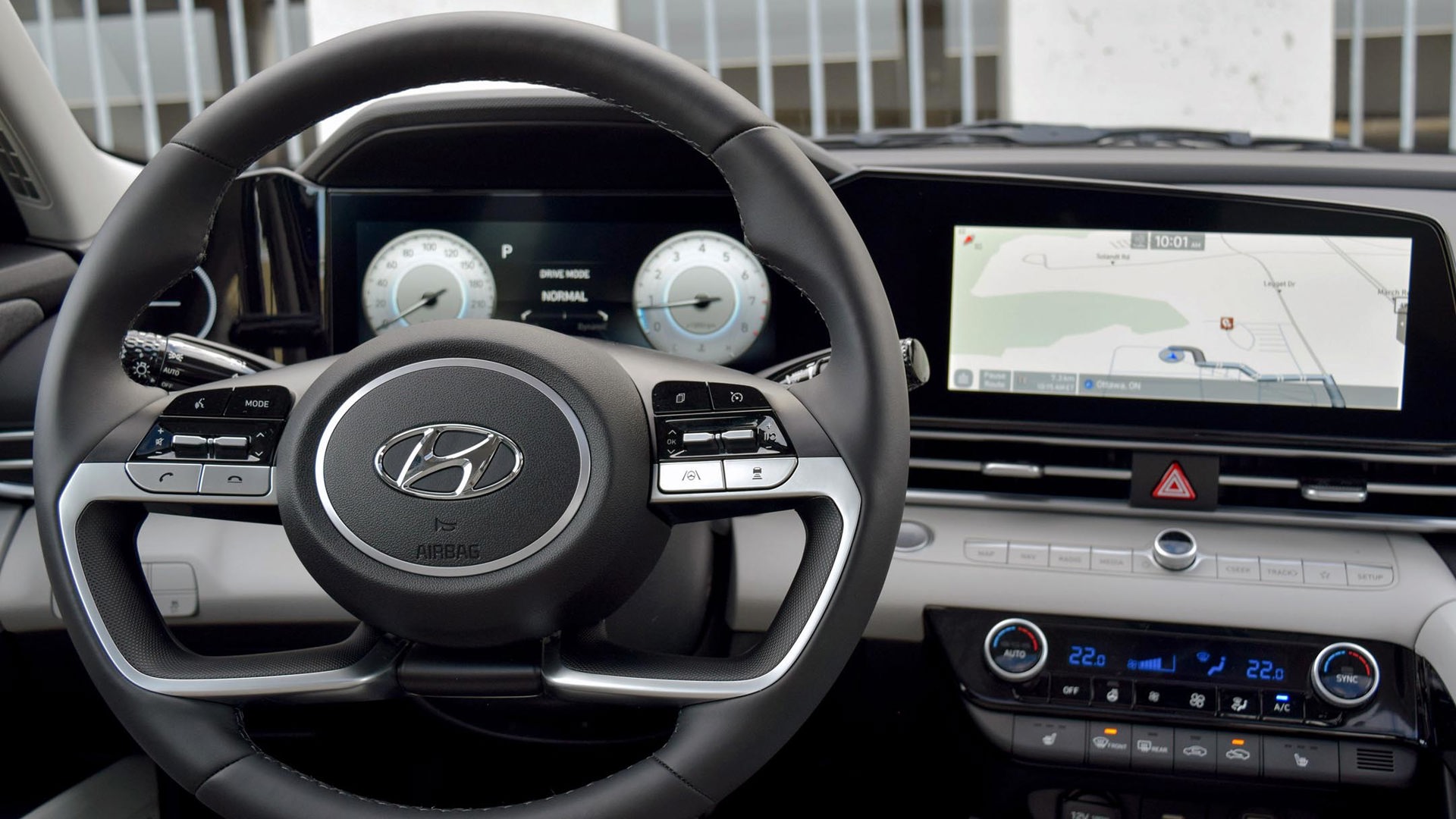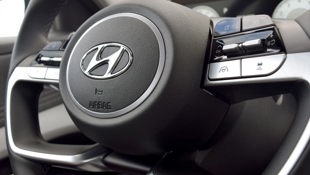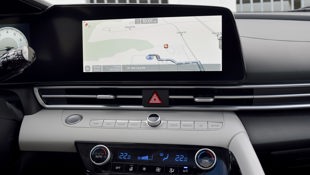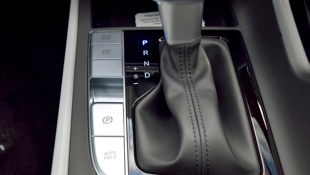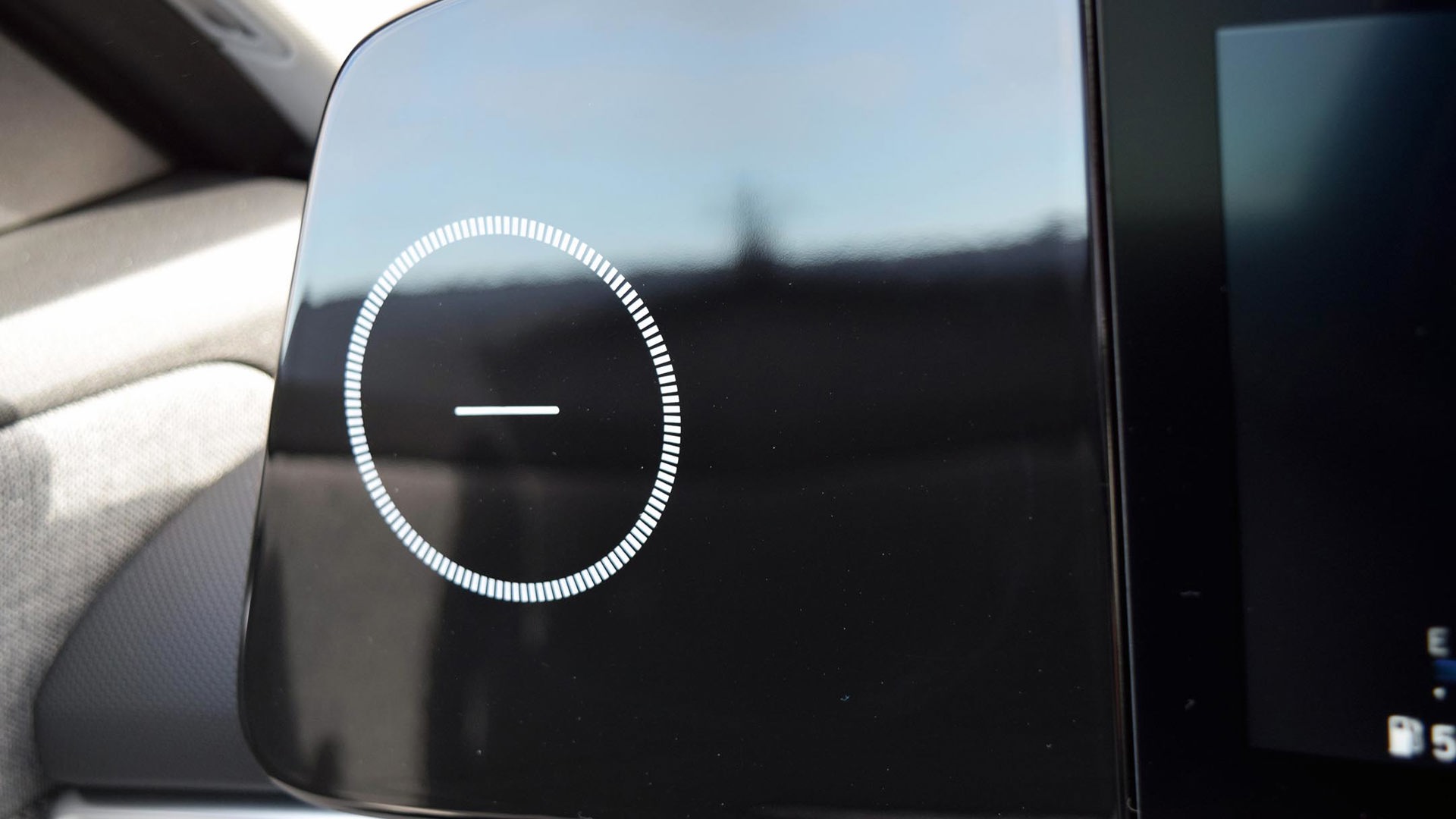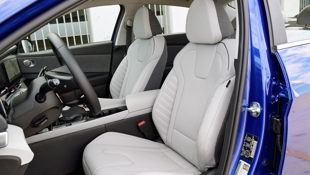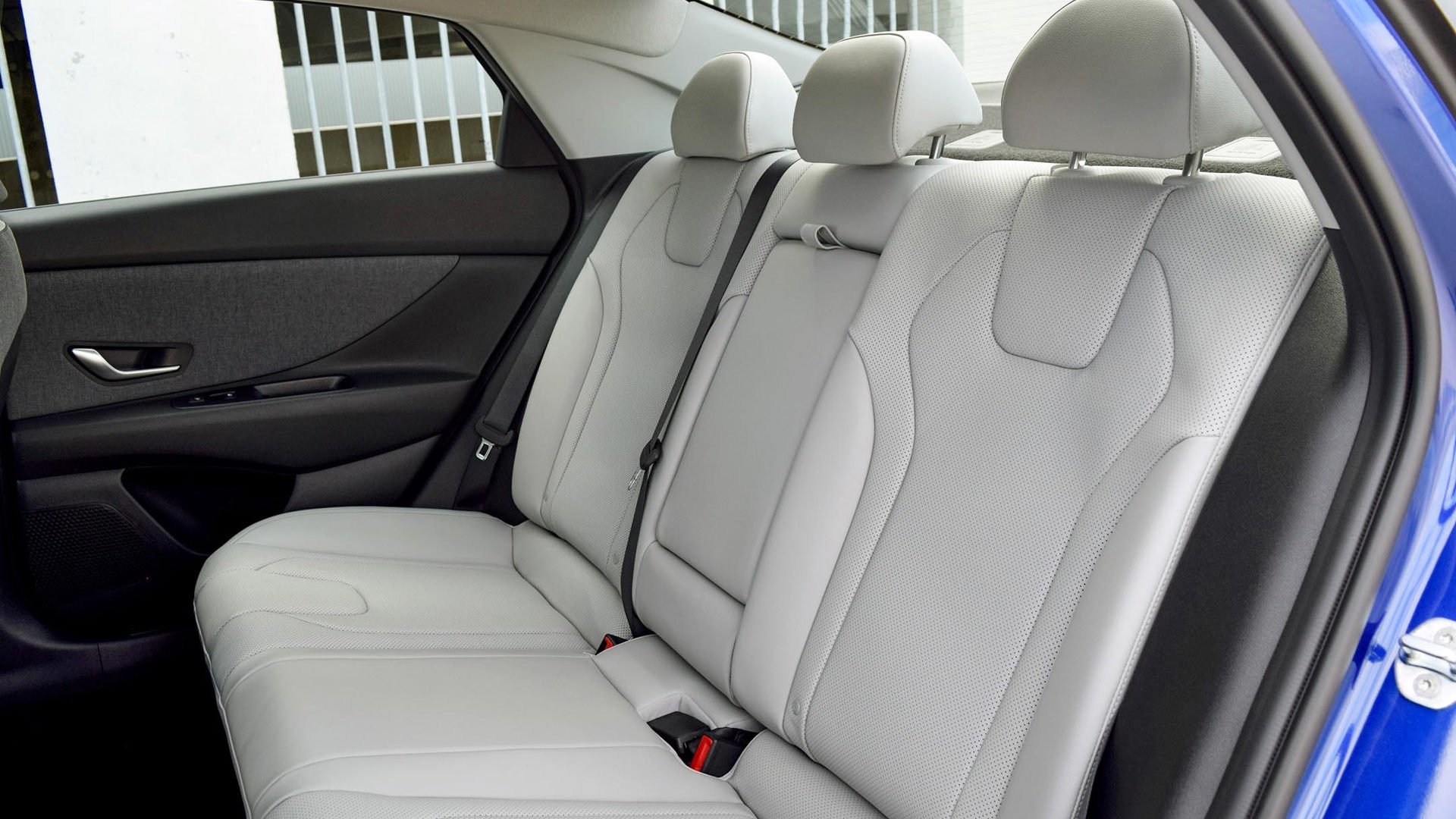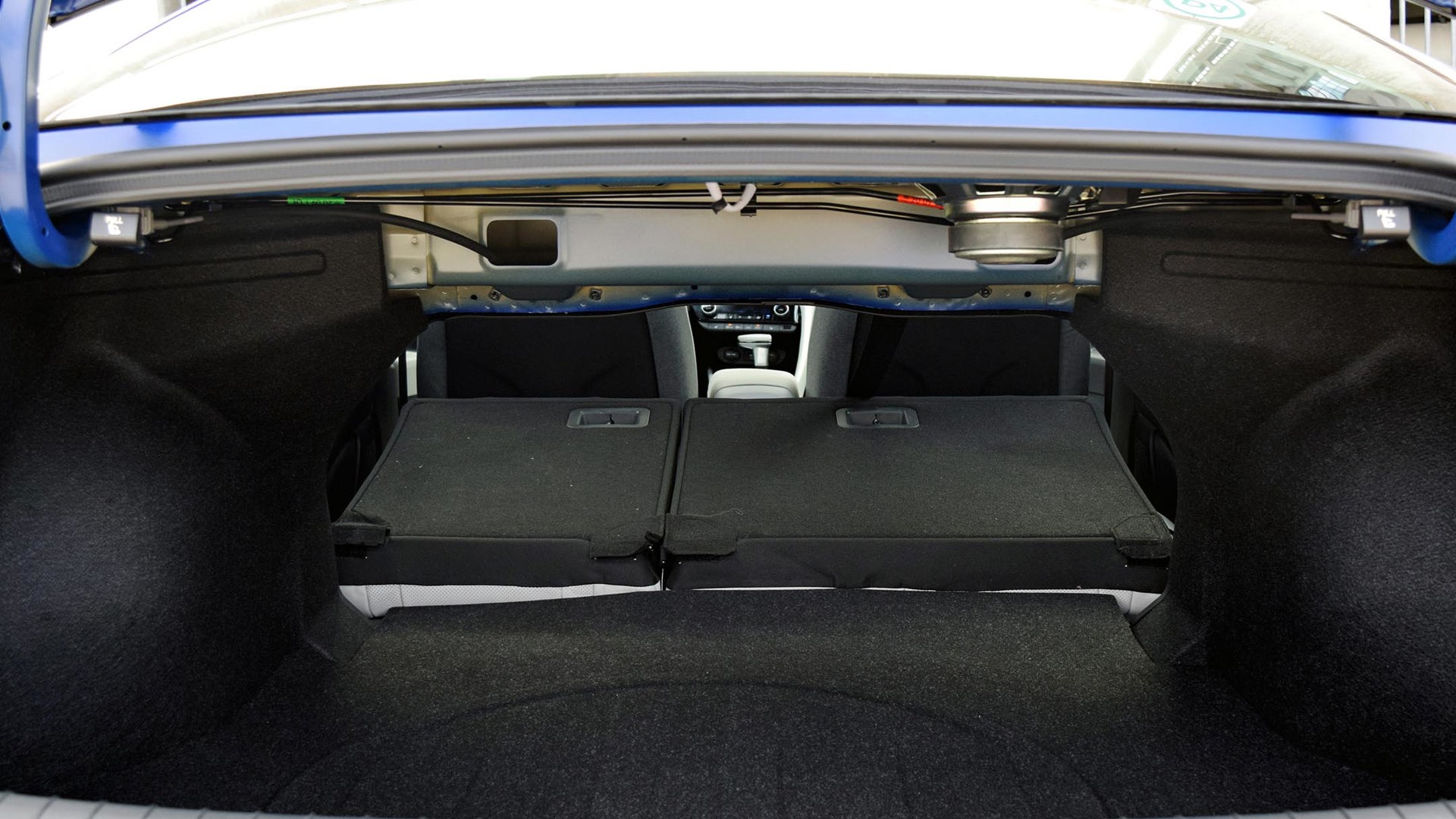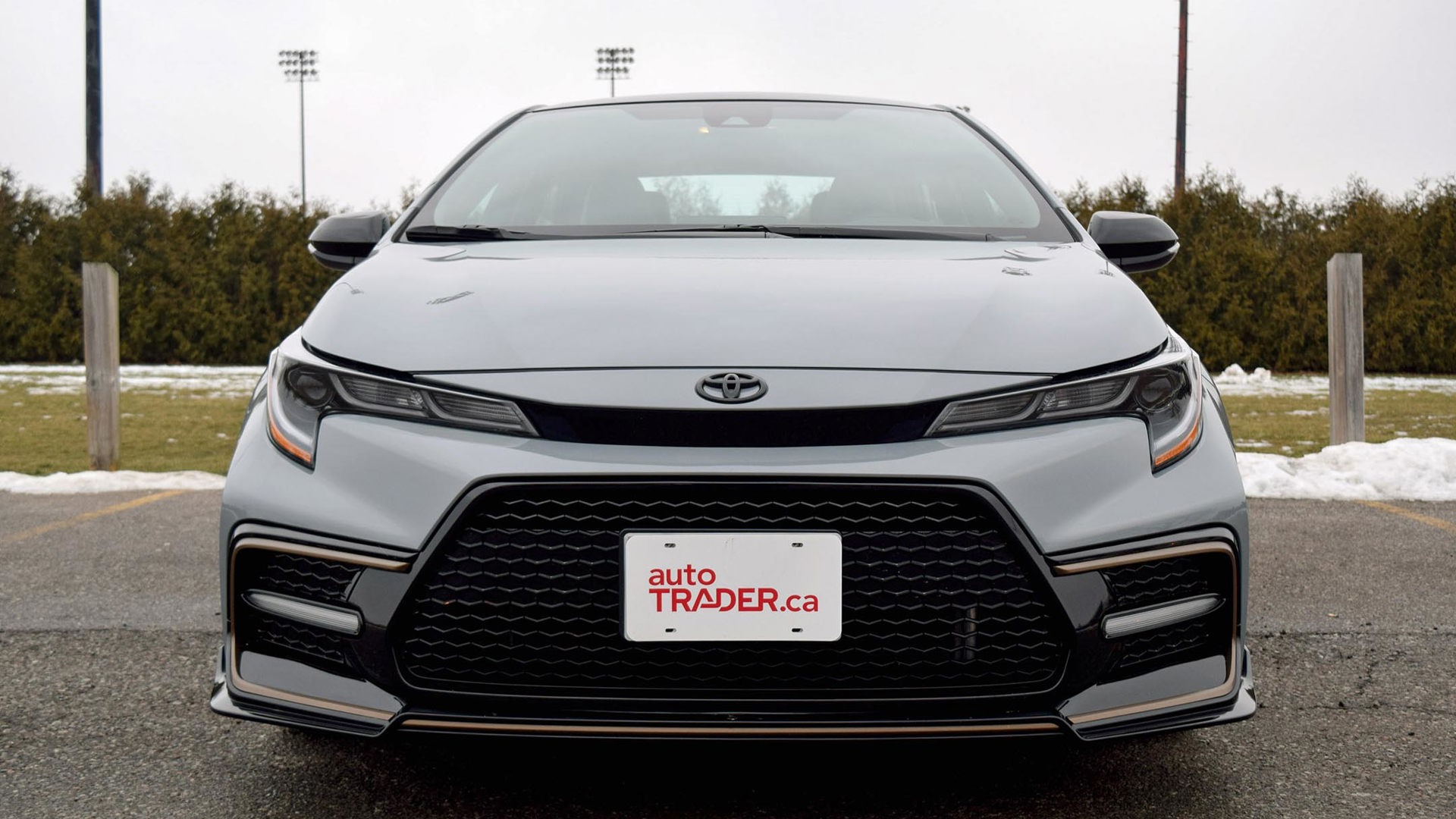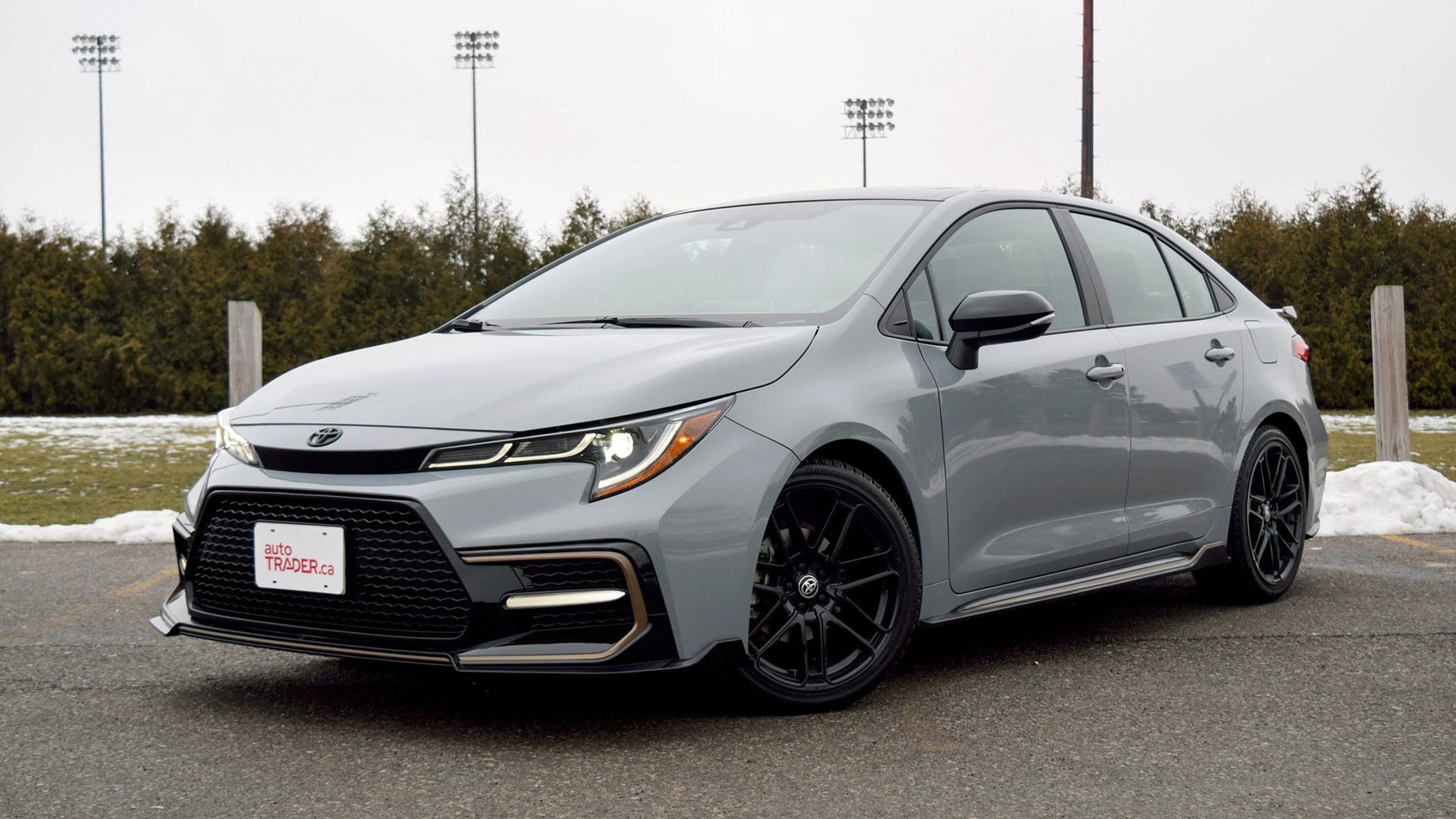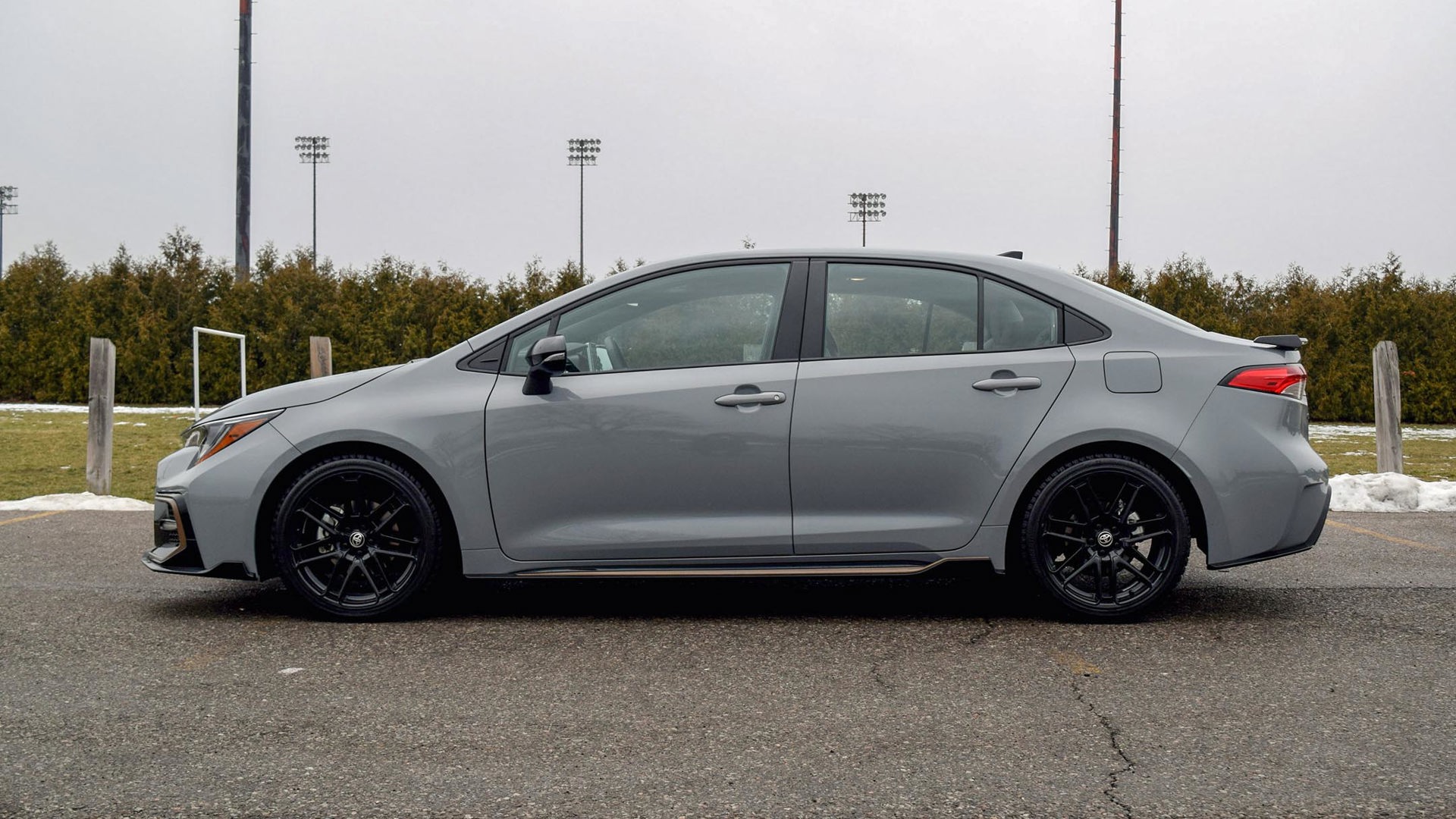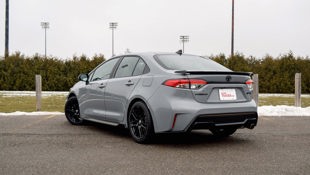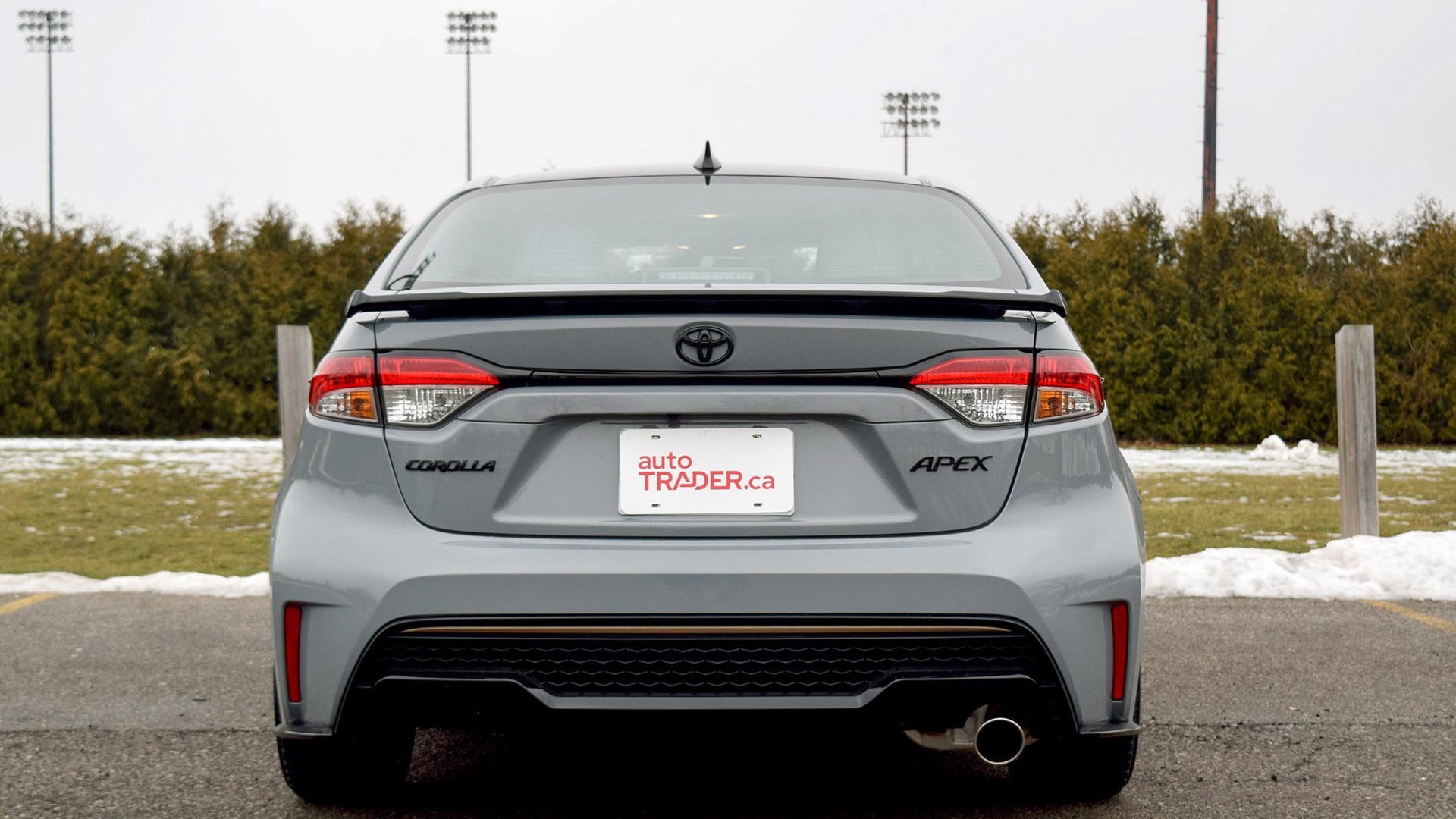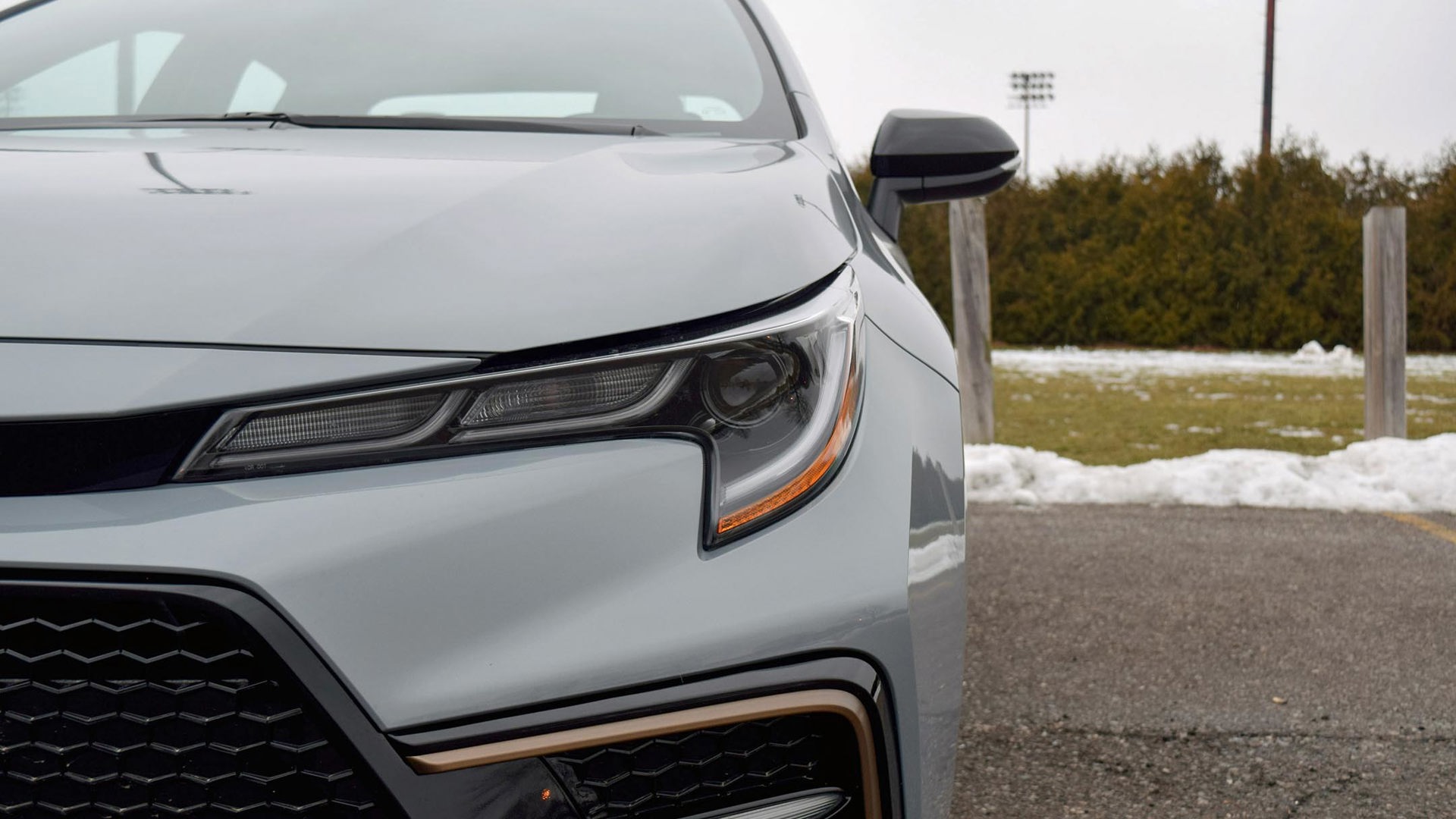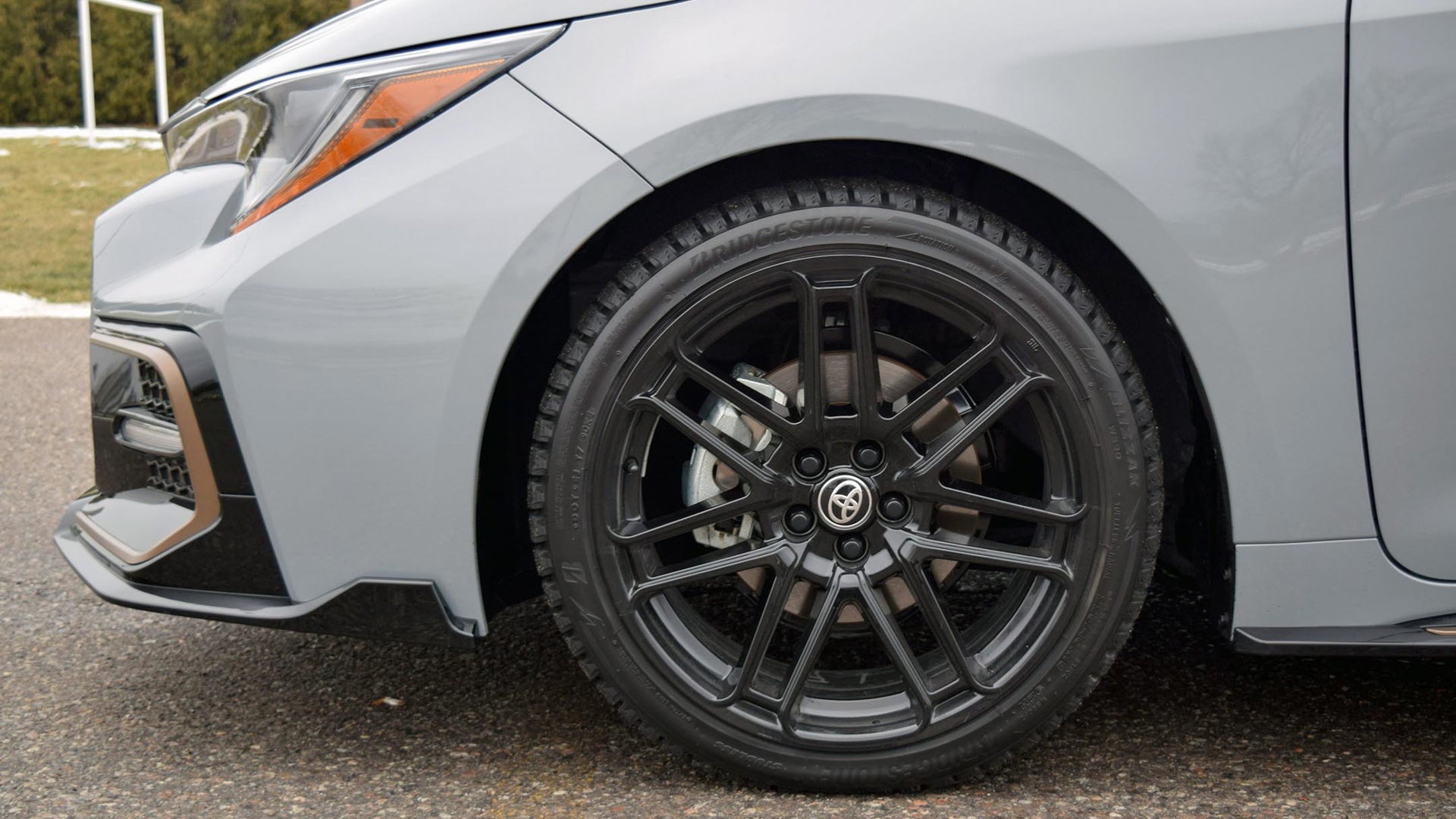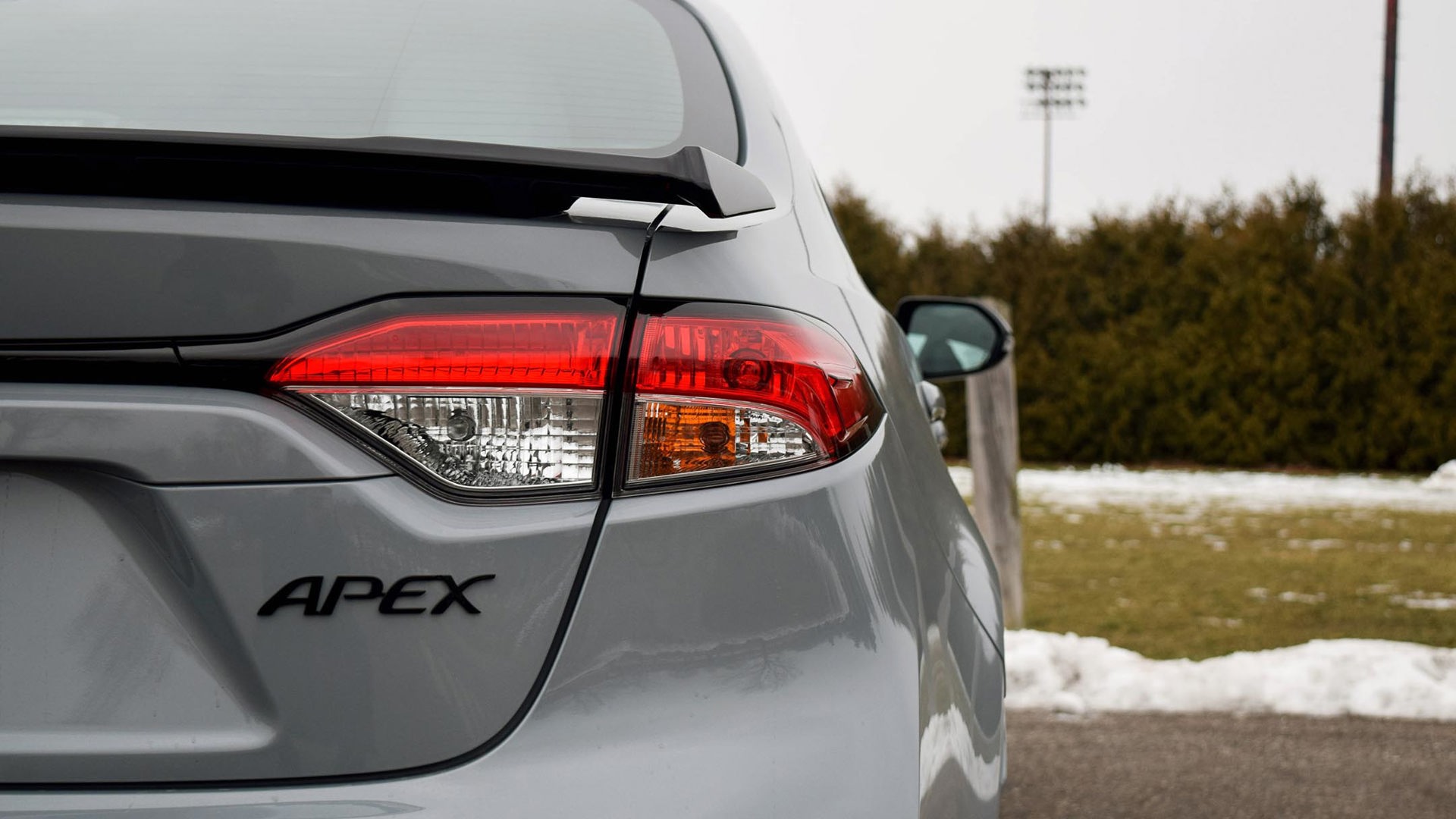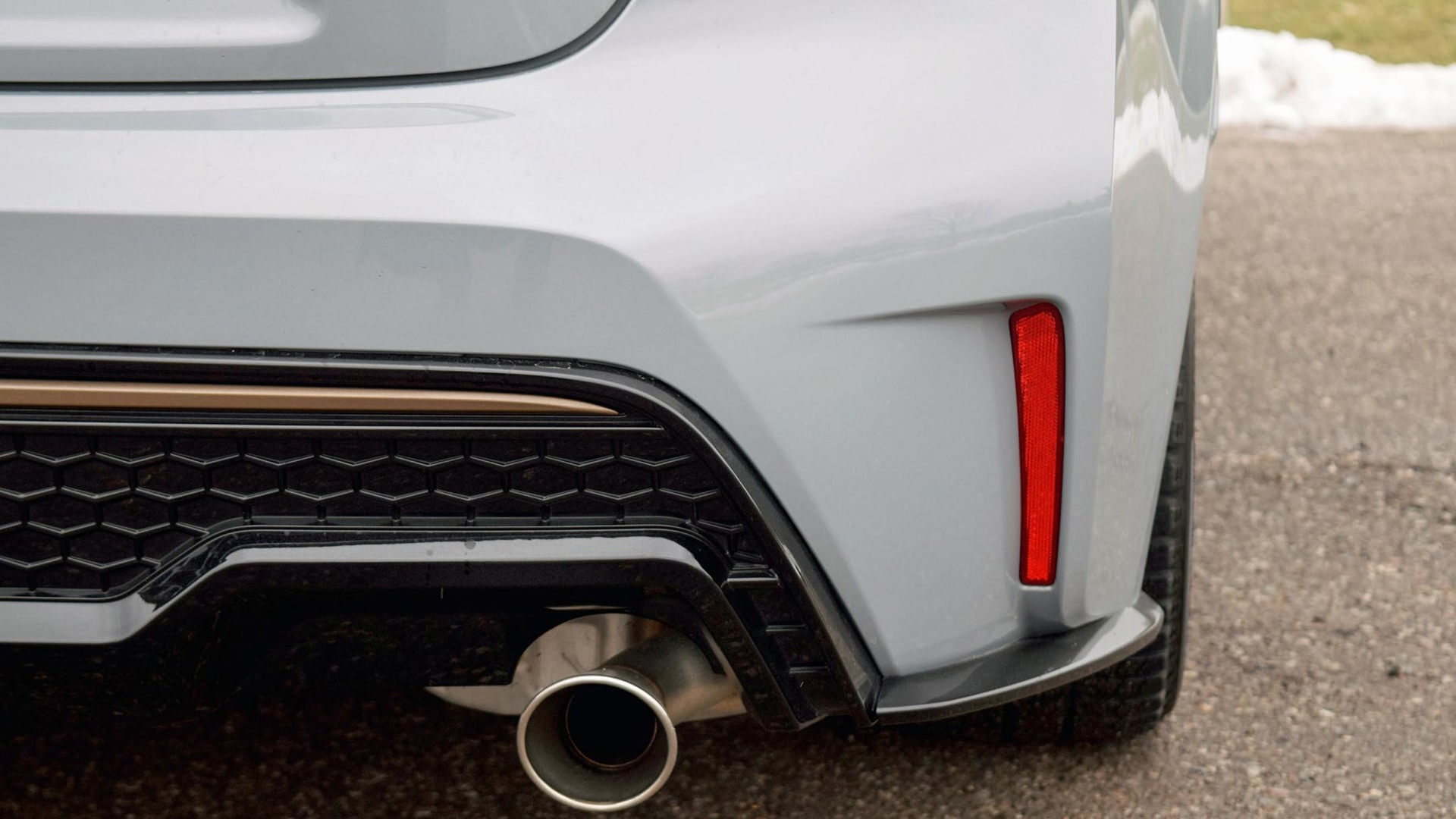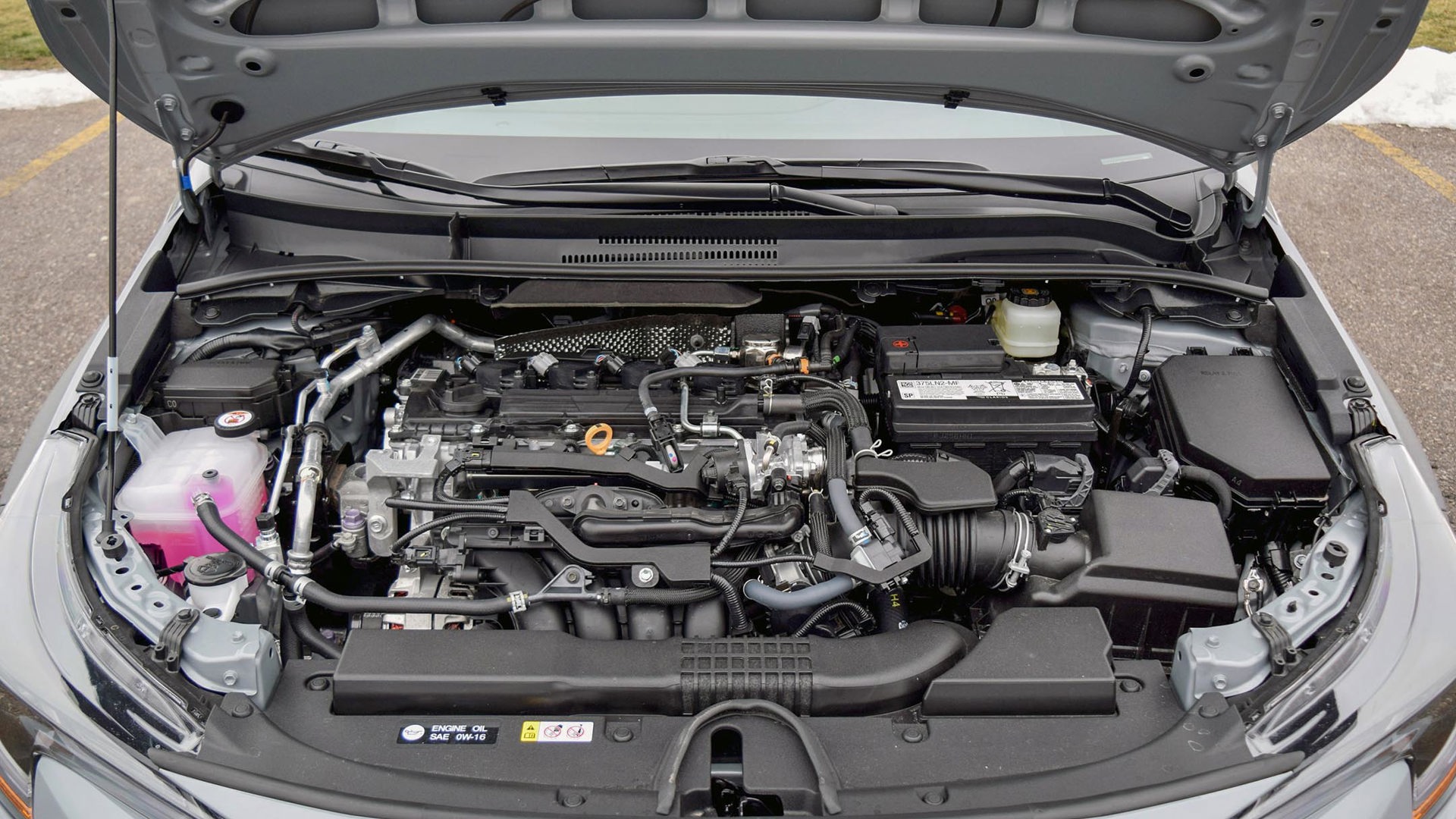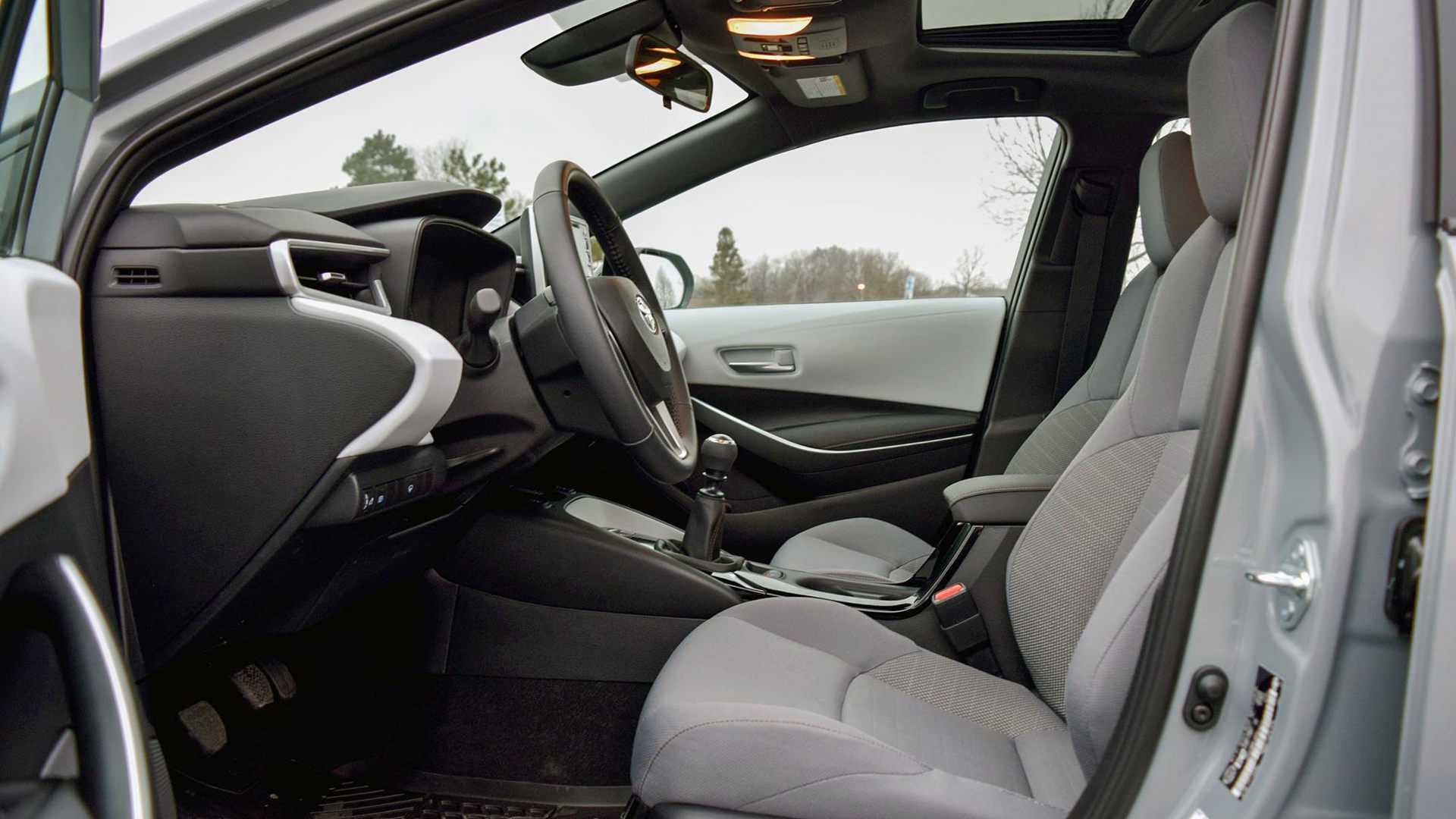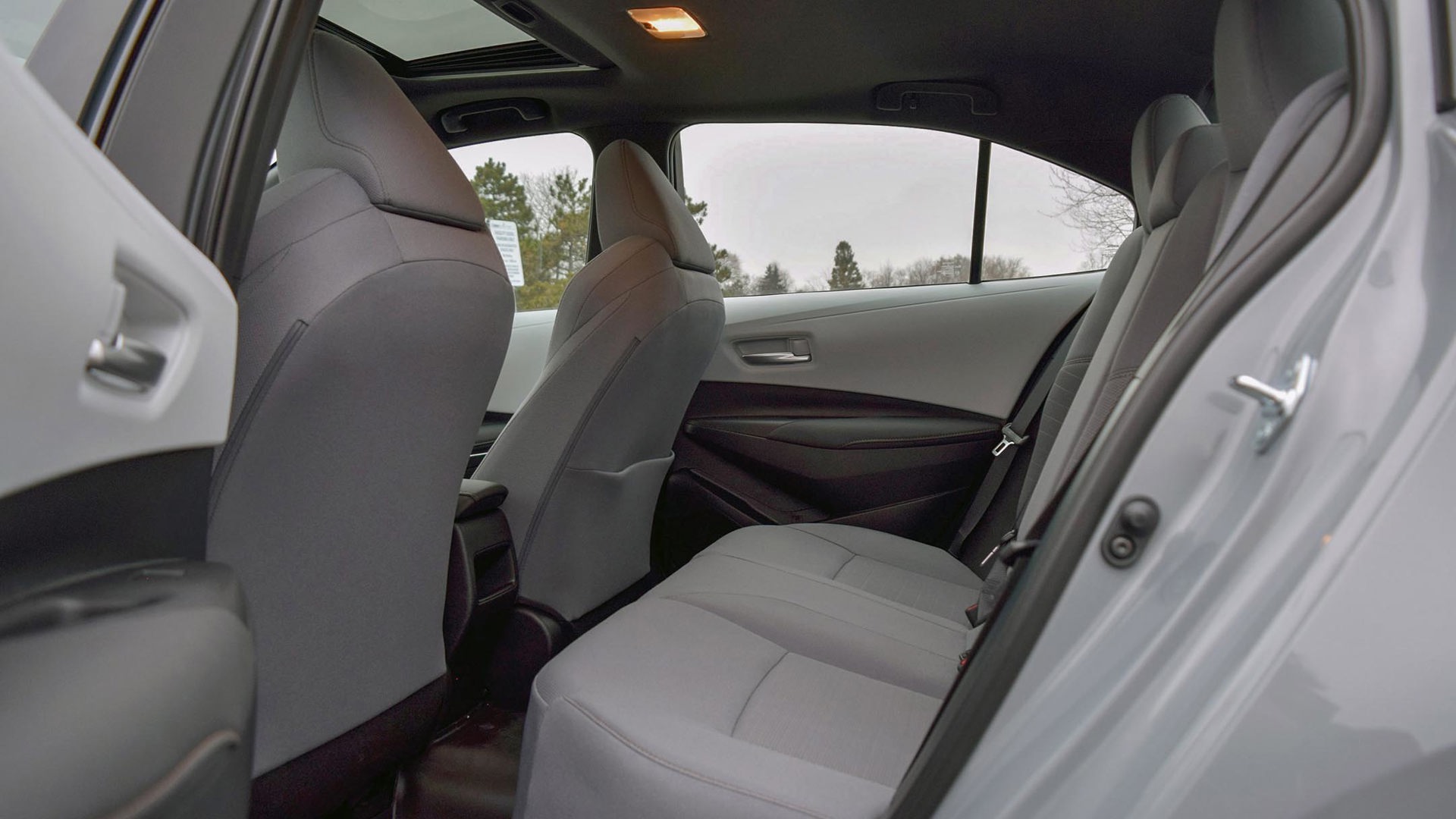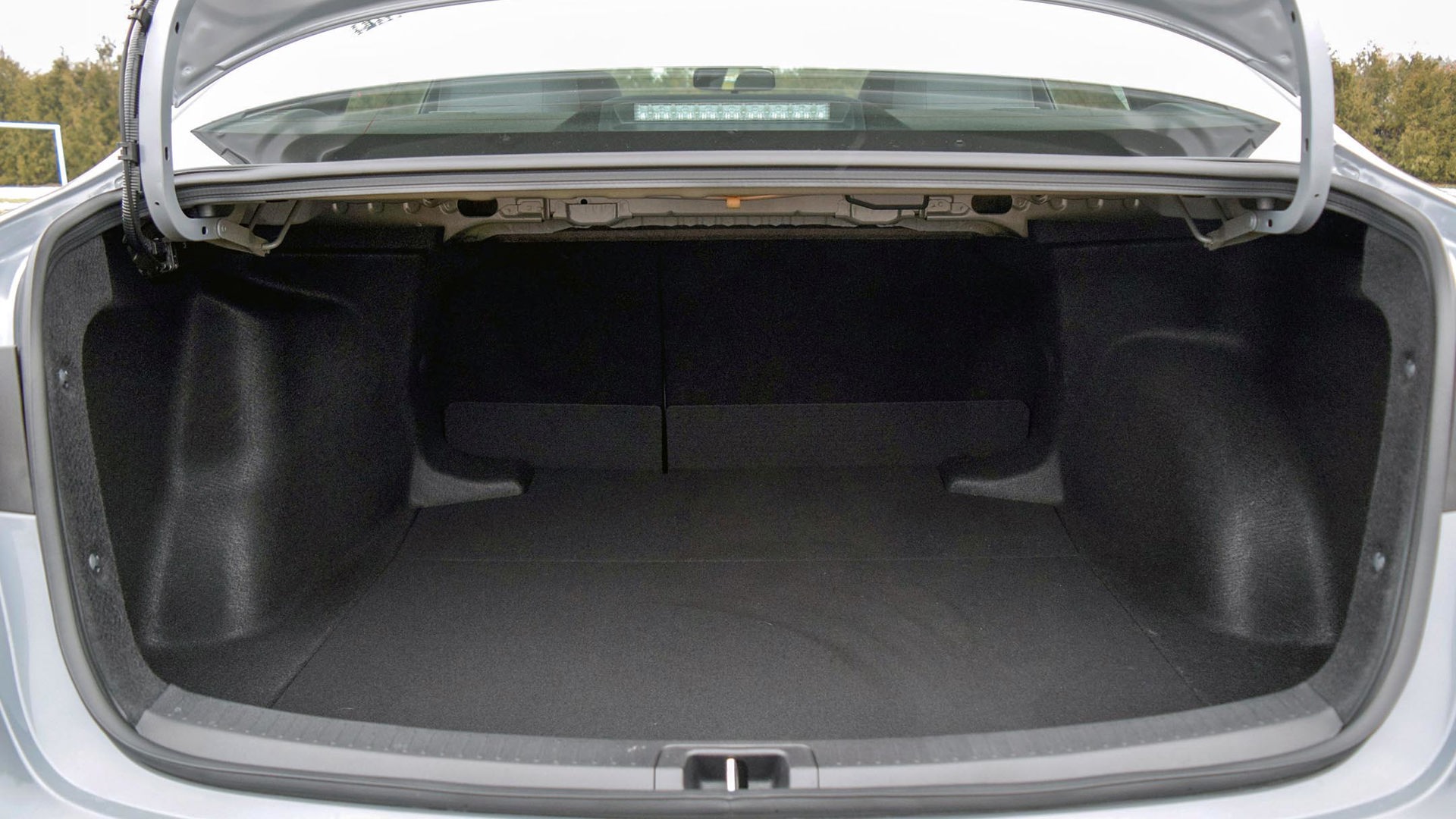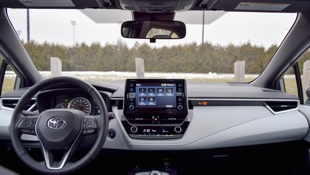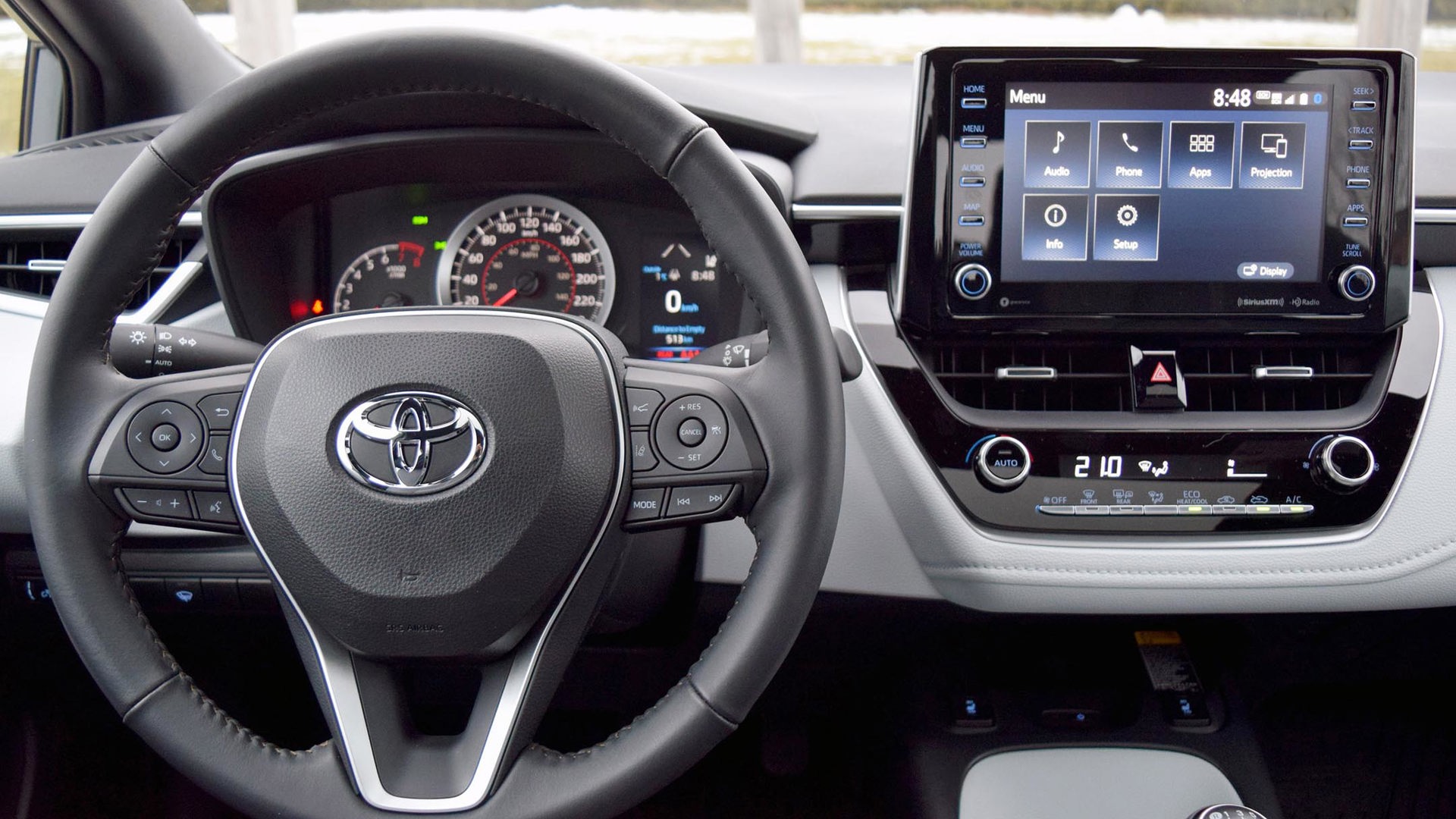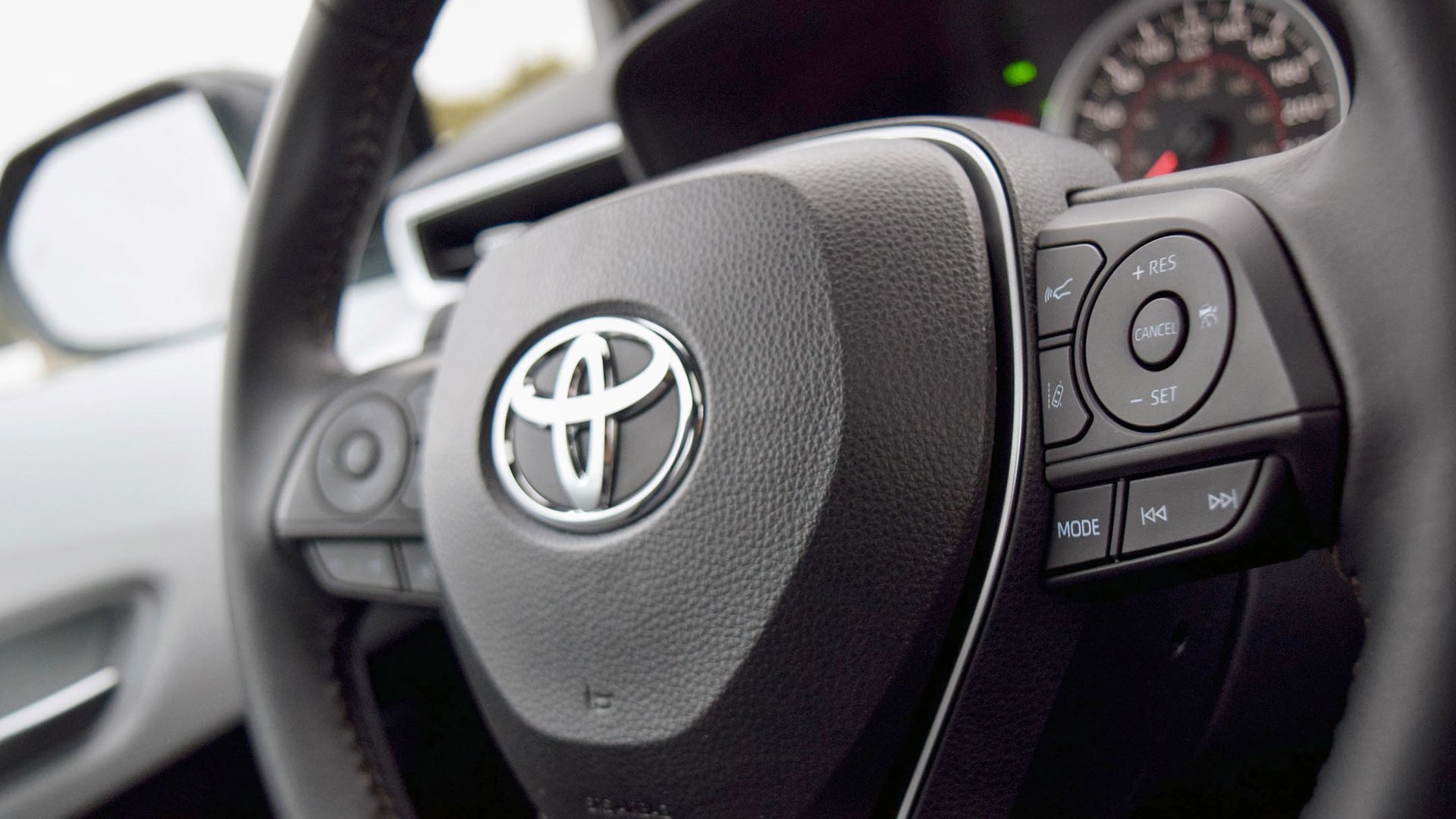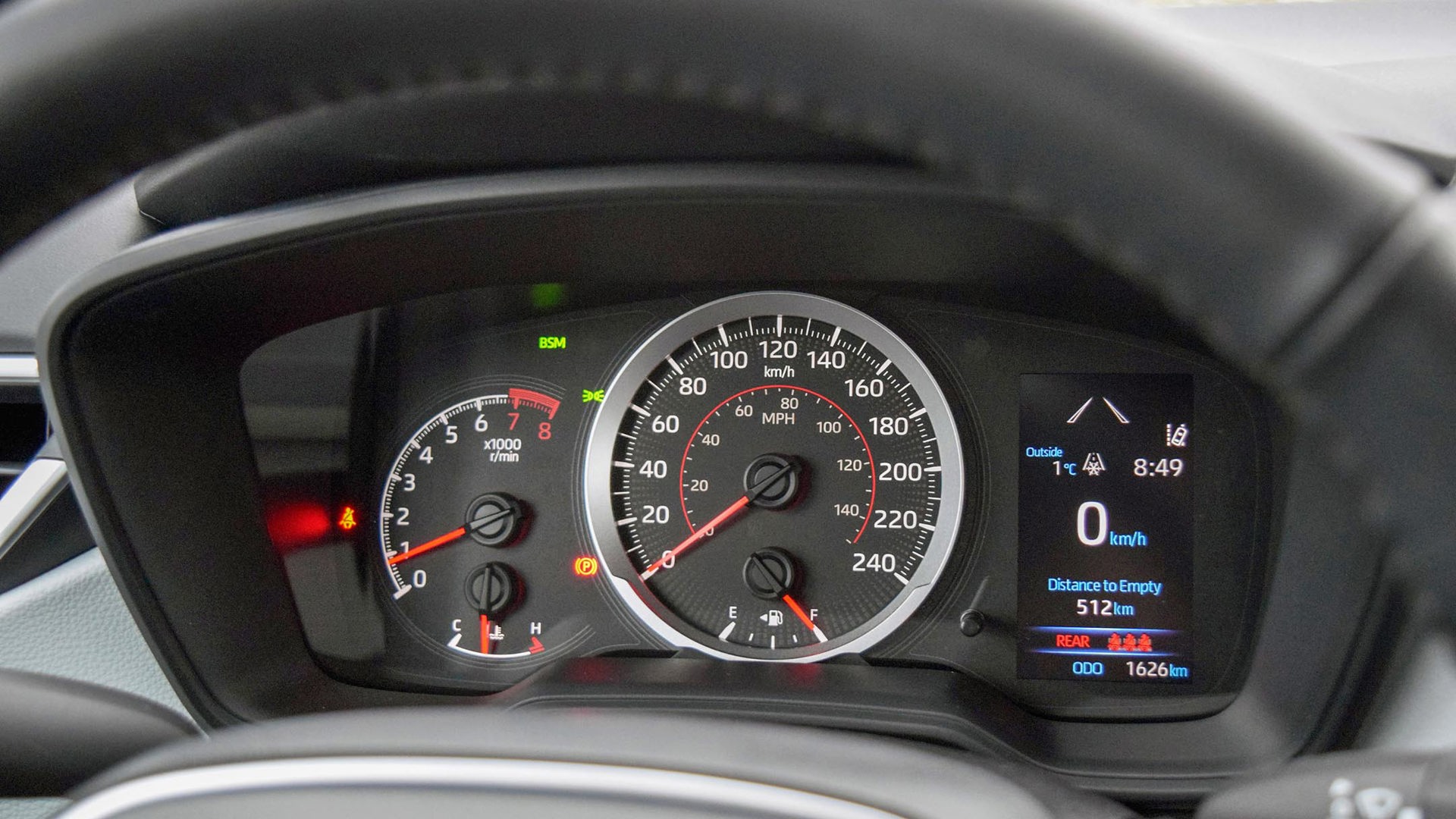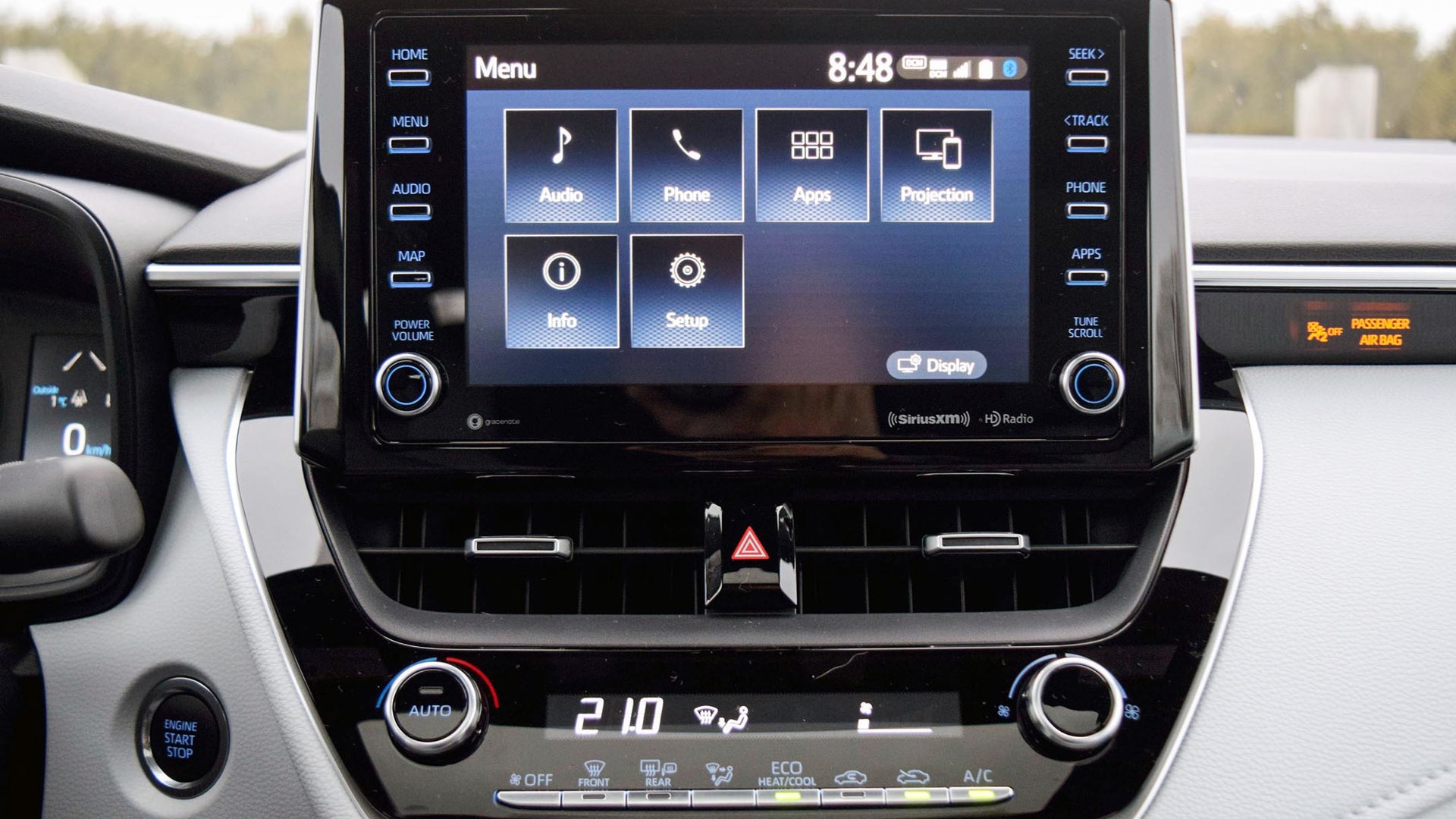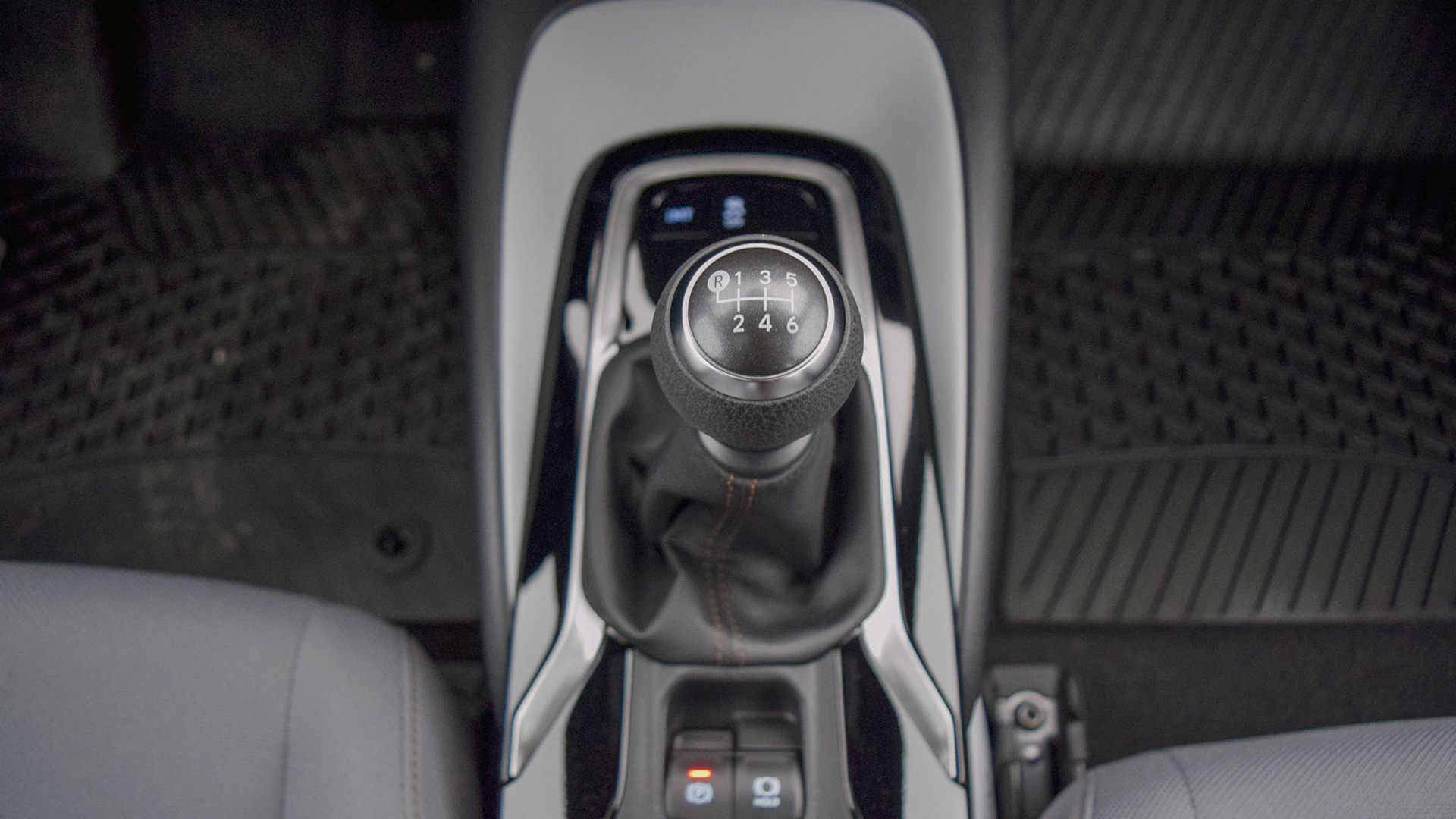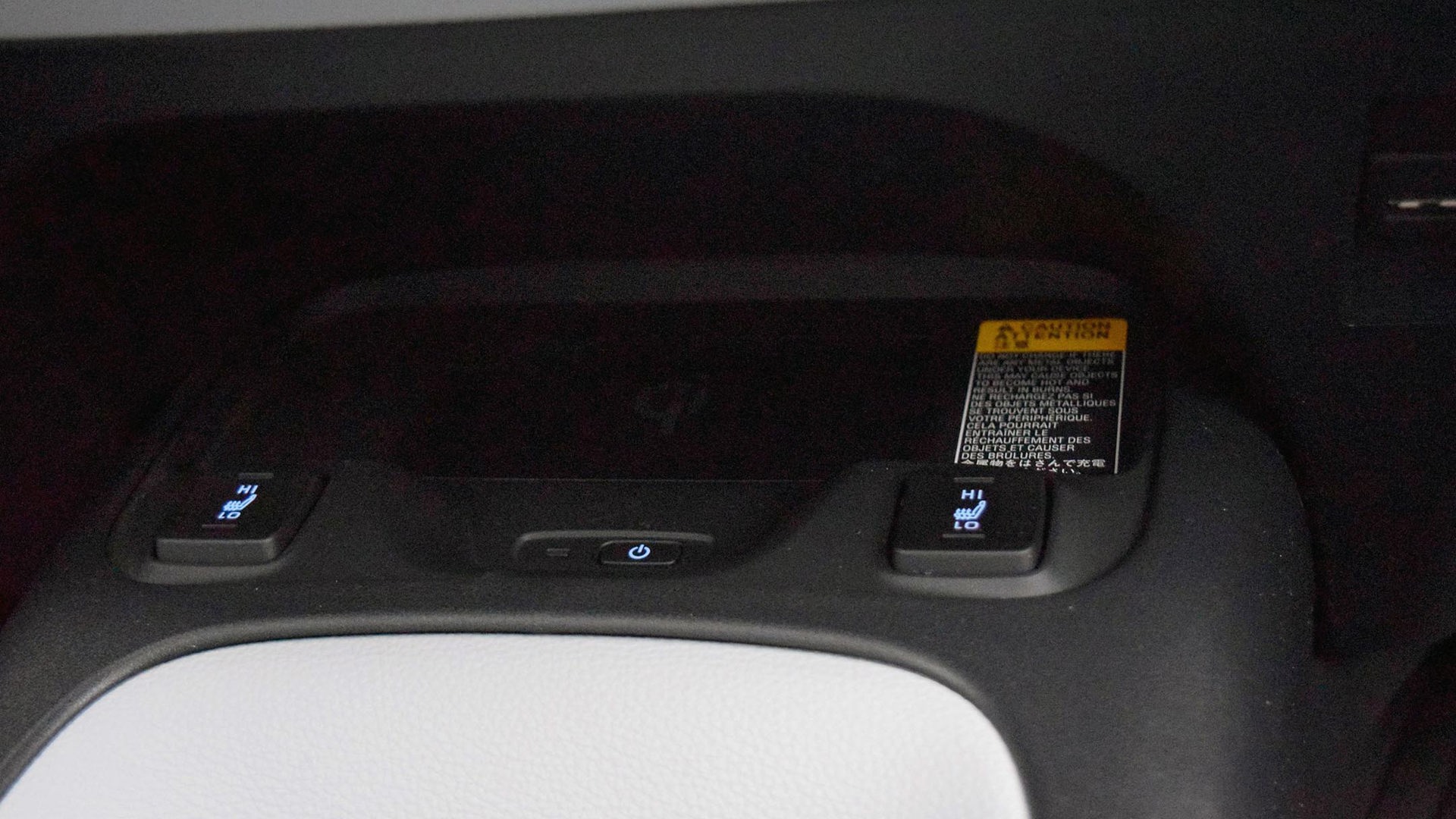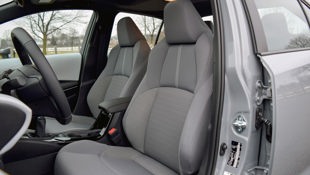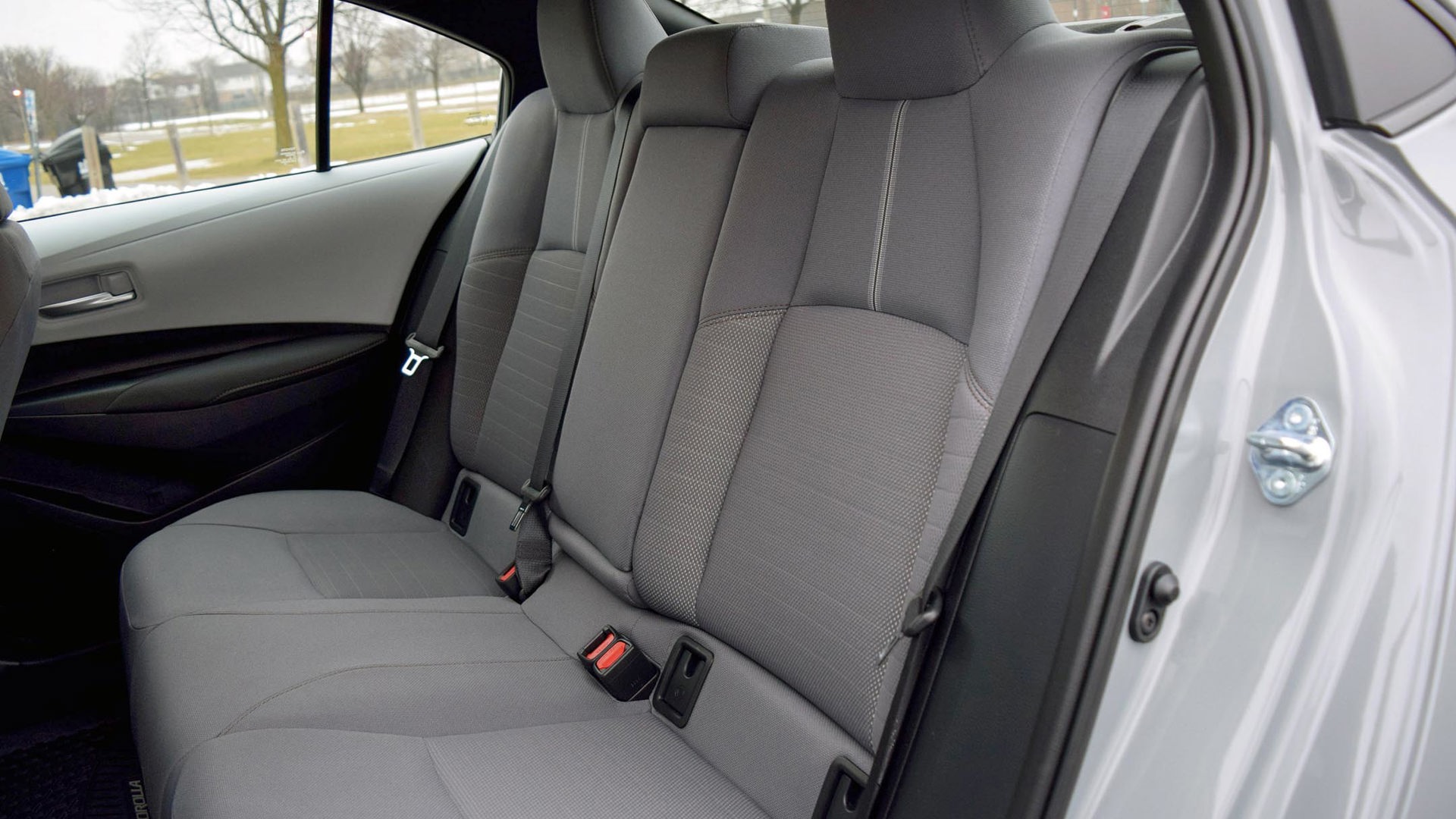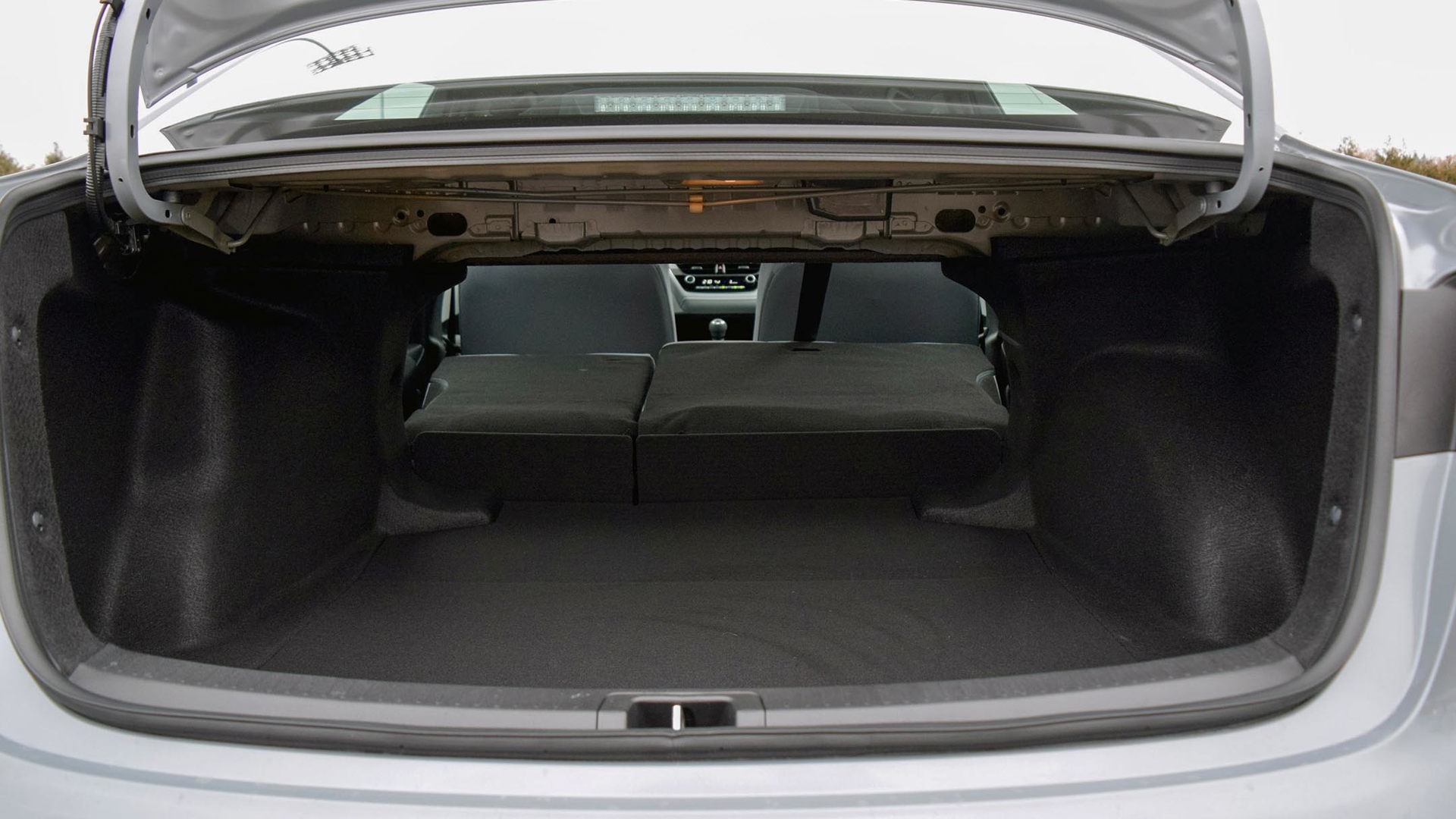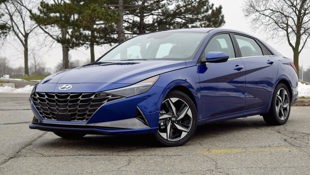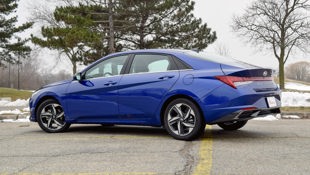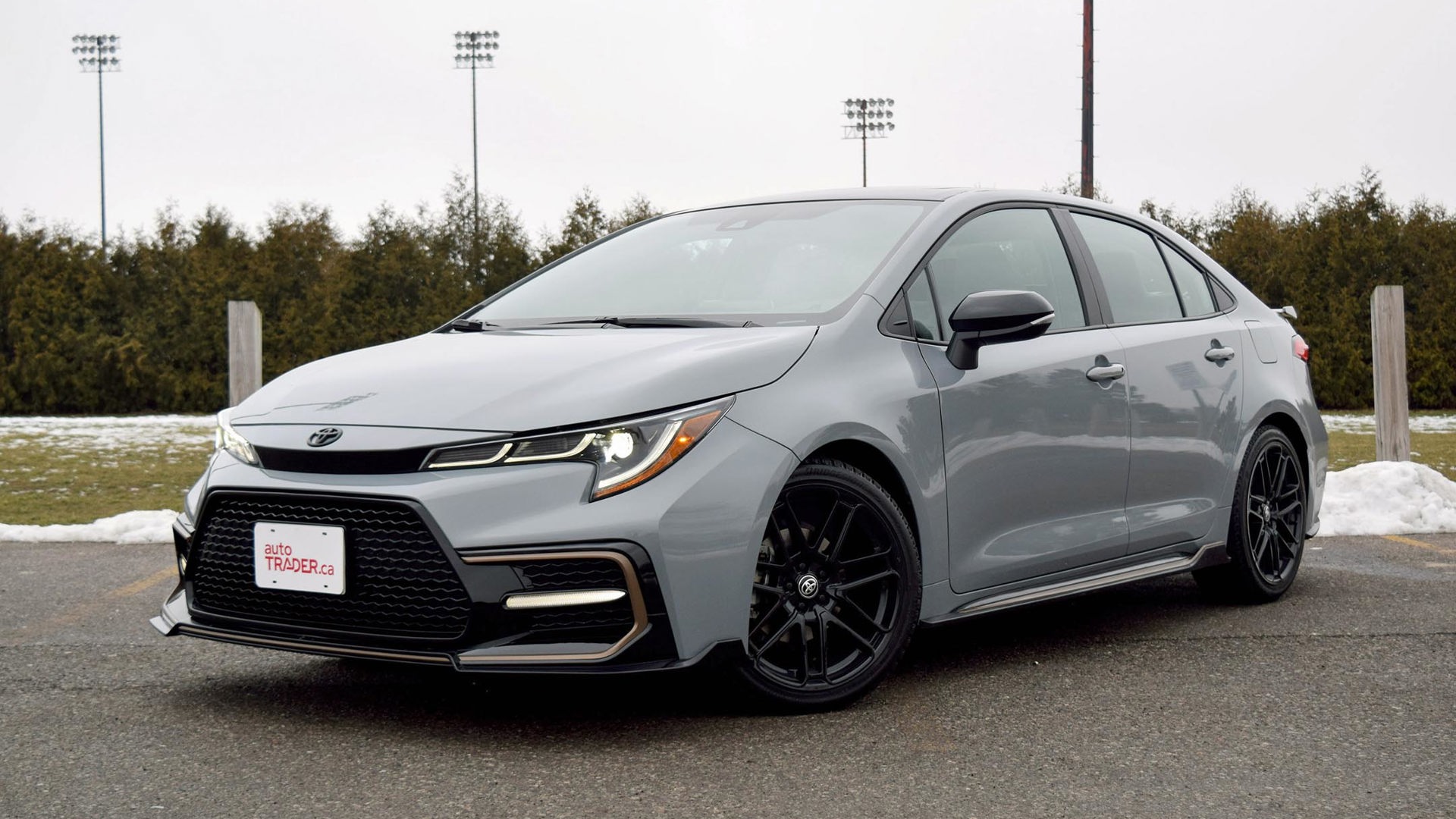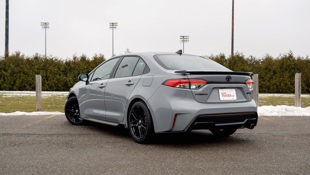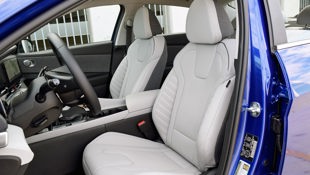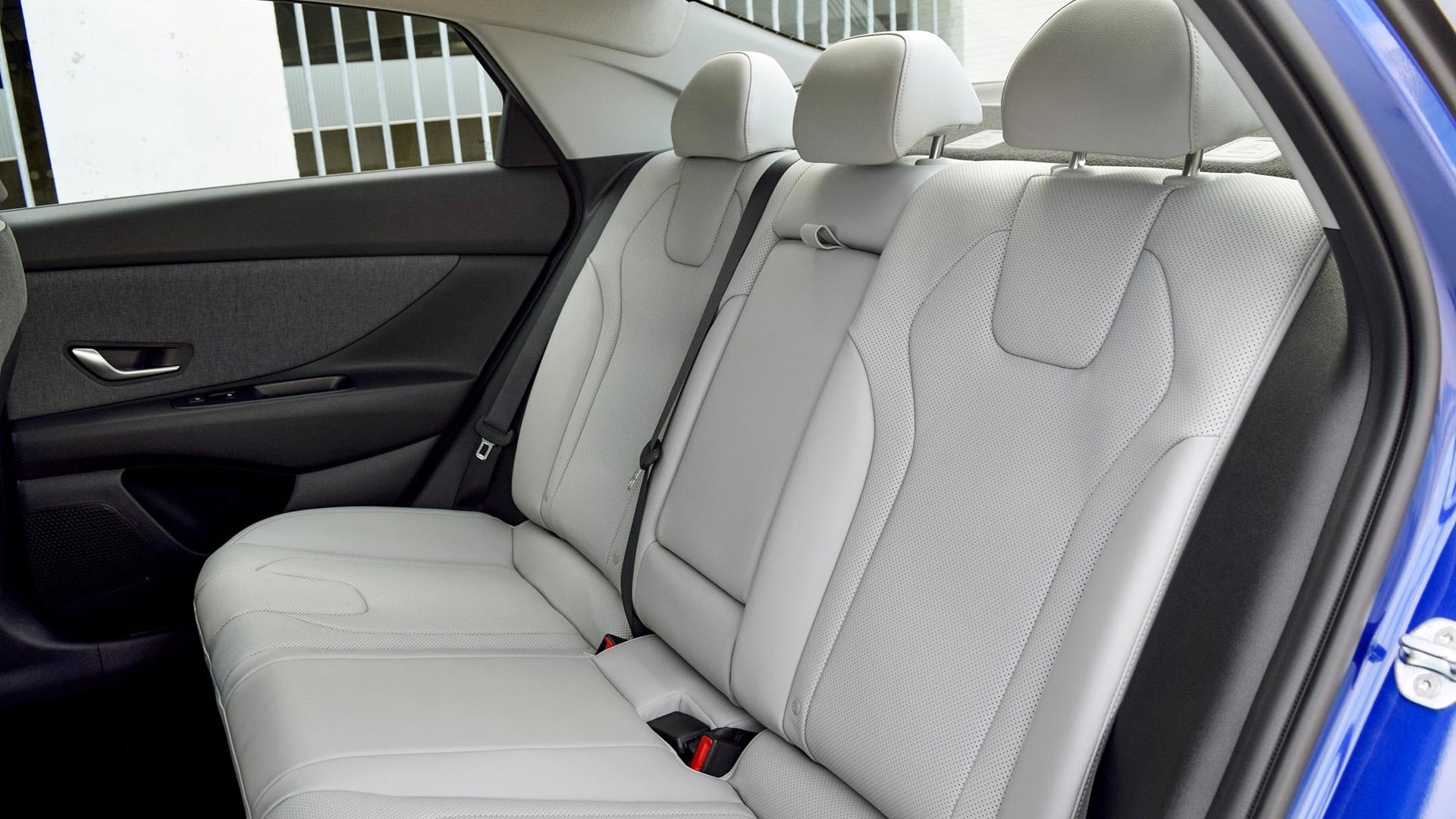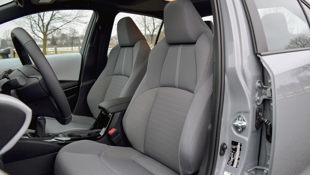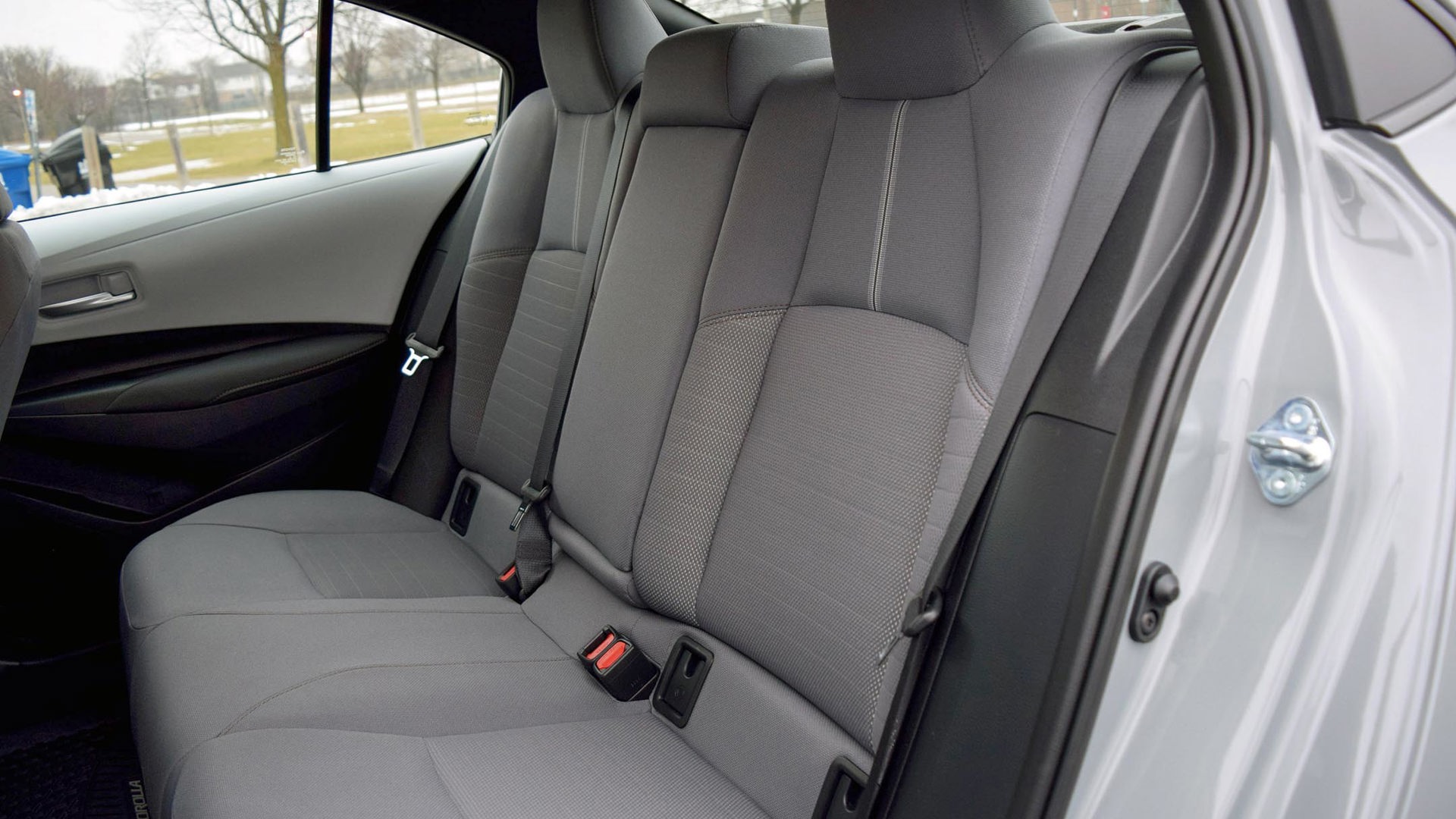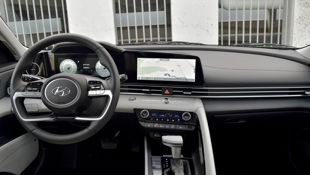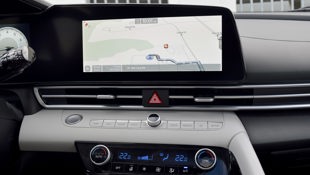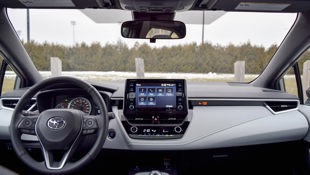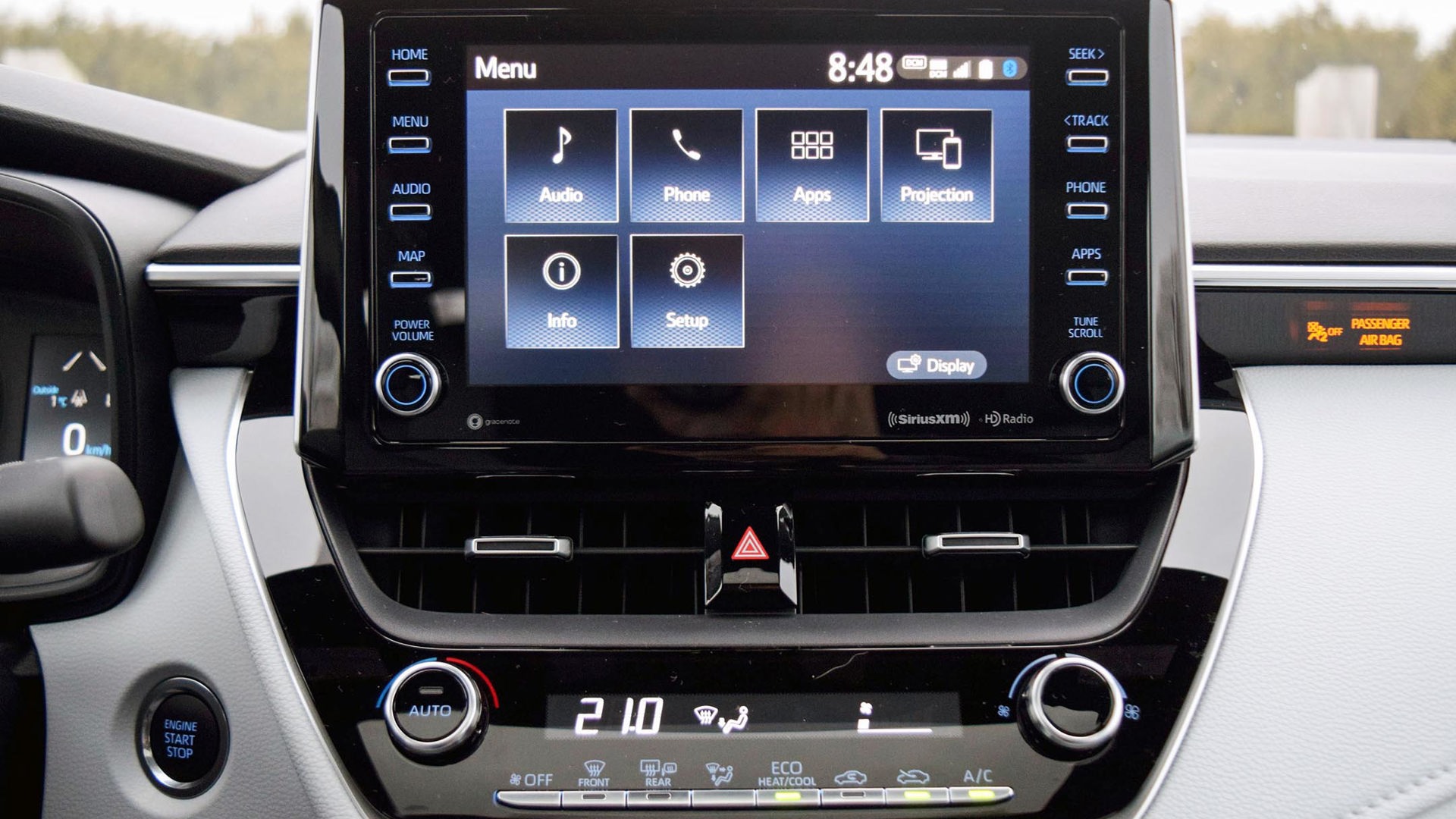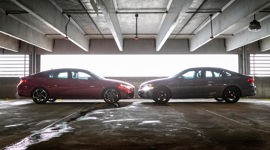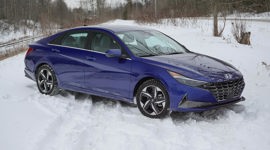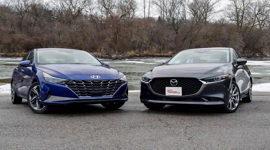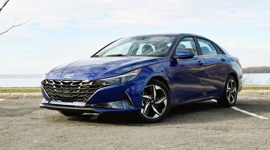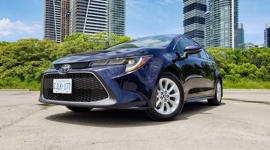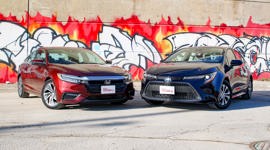Comparison Data
|
2021 Hyundai Elantra Ultimate
|
2021 Toyota Corolla SE
|
|---|---|
|
Engine Displacement
2.0L
|
2.0L
|
|
Engine Cylinders
I4
|
I4
|
|
Peak Horsepower
147 hp
|
169 hp
|
|
Peak Torque
132 lb-ft
|
151 lb-ft
|
|
Fuel Economy
7.5 / 5.7 / 6.7 L/100 km cty/hwy/cmb
|
8.4 / 6.6 / 7.5 L/100 km cty/hwy/cmb
|
|
Cargo Space
402 L
|
371 L
|
|
Base Price
$25,599
|
$22,590
|
|
A/C Tax
$100
|
$100
|
|
Destination Fee
$1,725
|
$1,670
|
|
Price as Tested
$30,324
|
$29,210
|
|
Optional Equipment
$2,900 – Tech Package, $2,700; Paint, $200
|
$4,850 – Apex Edition, $4,850
|
Crossovers are popular and spacious, but those looking for the best bang for their buck just might find what they’re looking for with the latest compact sedans.
The overhauled 2021 Hyundai Elantra proves that a compact car can be fully featured, and offers thrifty fuel consumption and affordable pricing to go with it. No matter how impressive the new Elantra is, though, it remains in the shadow of the 2021 Toyota Corolla, which carries a strong reputation through years of bulletproof reliability, albeit with few unnecessary frills.
Styling
The redesigned Elantra is a futuristic-looking car, and it could be a bit over the top for some shoppers. Creases in the body panel are crisp and aggressive, while the grille and headlight setup ensures that it looks distinct on the road. I appreciate the attention to detail at the rear end of the vehicle, where exterior designs can sometimes fall flat and lose their personality. However, anyone who finds the wedge-like profile of the Toyota Prius a bit dorky or the styling of the Honda Civic too busy will likely find the Elantra less than appealing, as it seems to combine elements of both.
The Corolla is a bit more conservative and handsome, and looks good without going over the top. The example tested was the new-for-2021 SE Apex Edition, which lowers the car a bit and adds a ground-effects package that reminds me of the sport compact tuner days. Thankfully, the large badging for the Apex model isn’t found on other versions of the Corolla.
As extroverted as the Elantra’s exterior is, the interior is a bit more conservative. The cabin is well laid out, with just a few notable exceptions. A large grab handle on the passenger side of the centre console impacts usability and comfort. And while Hyundai has added an area for a suction mount next to the gauge cluster to stick a smartphone, there are no nearby USB ports. Material choice in the cabin is varied, with some hard plastics in plain sight, serving to remind drivers that they’re in something less than premium.
That may sound like a common complaint about compact cars with these price points, but the Corolla seems to hide its less-savoury materials. That may be the only area of the Corolla’s cabin that excels, as everything else feels pretty standard fare. Unlike the Elantra, the Corolla has few high-tech showpieces, as the gauge cluster is a traditional arrangement compared to the Elantra’s optional digital dash. While the Corolla doesn’t have an issue as significant as that offensive grab handle in the Hyundai, the USB port used to connect with Apple CarPlay and Android Auto is located awkwardly on the underside of the dash. And when a device is connected, there’s nowhere to place it other than on the wireless charging pad, which makes it redundant.
Hyundai Elantra: 8/10; Toyota Corolla: 7.5/10
Safety
Advanced safety gear like adaptive cruise control, lane-keep assist, automatic high-beam headlights, and blind-spot monitoring are found on both of these vehicles, and even in some low-end trims. Everything but blind-spot monitoring is standard on the Corolla, and surprisingly, even those equipped with a manual transmission include it all, meaning you don’t have to sacrifice changing gears yourself for safety features and driver aids.
The base Elantra Essential lacks those safety features as standard equipment but they can be found on the mid-trim Preferred model. The top-trim Ultimate model gets a few additional tricks, like forward-collision warning that can help detect oncoming traffic during intersections with limited visibility. It also features rear parking sensors.
The Toyota Corolla was named a Top Safety Pick by the Insurance Institute for Highway Safety (IIHS). The institute has yet to test the 2021 Elantra, but the last generation scored the same result as its rival from Toyota.
Hyundai Elantra: 8/10; Toyota Corolla: 8.5/10
Features
Both vehicles feature Android Auto and Apple CarPlay support and can be had with automatic climate control, although the Elantra offers a dual-zone setup. There are heated seats in the front and rear of these vehicles, along with a heated steering wheel, but there are no options for seat ventilation. Both cars also offer wireless phone charging pads, and on paper, the two are evenly matched.
But the Elantra features a few more high-tech gizmos. For example, it comes standard with an eight-inch touchscreen infotainment system – the size of the upgraded screen in the Toyota – but can be swapped for a 10.25-inch display in higher trims. This system is fast and easy to use, and looks great next to the available 10.25-inch digital gauge cluster, which features custom themes. Even ambient lighting is available in the Elantra, with 64 colour choices to help make the cabin feel extra special.
The Corolla lacks these features, sporting either a seven- or eight-inch infotainment display, with graphics that hardly look modern or flashy. And while it lacks features to wow your friends, the manual transmission models add a rev-matching feature for downshifts, leading to smoother gear changes and the feeling of zen that comes with them.
Hyundai Elantra: 8.5/10; Toyota Corolla: 7/10
User Friendliness
Without a doubt, Toyota prioritizes simplicity. Only an item like the location of that USB port stands out for its poor ergonomics, and while the infotainment interface isn’t pretty or fast, it has large on-screen buttons that make it easy to navigate. The availability of the rev-matching manual even makes driving stick easier.
The result of all the screens in the Elantra is that you’re able to get a load of information quickly, but setting up the screens or changing settings may have you confused about which interface to use. Fortunately, the Elantra’s larger screen feels a bit easier to navigate, and the flashier on-screen graphics make it a little more pleasant to use.
Hyundai Elantra: 8/10; Toyota Corolla: 8/10
Practicality
Significant strides – and growth spurts – over the past few years have led to compacts becoming far more practical than they used to be. The Elantra features 402 L of cargo space, while the Corolla offers 371 L. The Elantra is much more spacious, especially in the rear seat where there’s more head- and legroom than in the Corolla.
Hyundai Elantra: 7.5/10; Toyota Corolla: 6.5/10
Comfort
The extra space helps provide the Elantra with a more comfortable driving experience. Even the seats in the front feel well spaced out, with plenty of elbow and shoulder room. The Corolla feels cramped in comparison.
Any worries about the rear torsion-beam suspension in the Elantra are relieved quickly, as the vehicle rides confidently and smoothly. The most significant concern in the Elantra comes with noise, specifically tire and wind noise. While the engine is kept muted by the transmission, you’ll notice the extra noise penetrating the cabin.
When it comes to the Corolla, those seeking a comfortable ride should avoid the SE Apex Edition; its lowered ride height and revised suspension setup proved incredibly stiff and uncomfortable. Fit only for the hardcore, it’s simply too much and unbearable for everyday driving. Fortunately, all other trims of the Corolla are far more comfortable to drive.
Hyundai Elantra: 8.5/10; Toyota Corolla: 7/10
Power
Under the hood of the Elantra is a 2.0L four-cylinder engine with 147 hp and 132 lb-ft of torque. Base models can be had with a manual transmission, while mid and top trims feature a continuously variable transmission (CVT) that delivers responsive acceleration at low speeds and impressive fuel consumption when cruising. The Elantra comes in a few other trims, including an efficient hybrid model and a pair of sporty models. As tested, the powertrain is just adequate for the daily commute.
The Corolla offers two gas engines: a 1.8L four-cylinder engine that makes 139 hp, and a punchier 2.0L engine with 169 hp. Our SE model featured the latter engine and was paired to a six-speed manual, although a CVT is available, too. The stick shift is surprisingly good, with smooth action and gates that are hard to miss. Even the clutch action is decent, which can sometimes feel like an afterthought in these compact cars. While the Elantra feels quicker from a stop, as well as quieter when cruising, the Corolla felt surprisingly capable at higher speeds and was able to keep up with traffic, shedding the slowpoke stereotype of the Corolla.
Hyundai Elantra: 7.5/10; Toyota Corolla: 8/10
Driving Feel
The Corolla equipped with the SE Apex Edition package also led to a fun driving experience, assuming you can bear the harsh ride. Steering is well-weighted, and the chassis is responsive to even quick and twitchy inputs. Standard models are surprisingly agile feeling as well, a by-product of the well-developed architecture that underpins several Toyota vehicles.
While the Corolla is sharp and responsive, the Elantra feels a tick behind in that regard. You’ll notice the light steering and limited feedback. For those who want something smooth, quiet, and easy to pilot, the Elantra will do the trick. Those seeking more fun will want to check out the Corolla.
Hyundai Elantra: 7/10; Toyota Corolla: 8/10
Fuel Economy
The Hyundai Elantra is rated to return 7.5 L/100 km in city driving, 5.7 on the highway, and 6.7 combined. Those scores are for the CVT-equipped model, while manual models see 7.8 L/100 km combined. Our experience with the Elantra blew those scores away, and in a route that had a perfect split of highway and city driving, we saw just 5.8 L/100 km.
When it comes to the Corolla, manual models with the 1.8L are expected return 8.0 L/100 km in the city, 6.0 on the highway, and 7.1 combined; similar figures are reported with the CVT. Models equipped with the 2.0L see a wider range between the two transmission options: 7.6 L/100 km in the city, 5.8 on the highway, and 6.7 combined for the CVT, but 8.2 / 6.5 / 7.4 L/100 km city / highway / combined for the manual. As expected, the Apex Edition is thirstier, with the CVT version rated at 7.0 L/100 km combined and the manual at 7.5 L/100 km combined – which was our result after taking the same test route as the Elantra.
Hyundai Elantra: 9/10; Toyota Corolla: 7/10
Value
The Elantra starts at $17,899 for the Essential trim model, while a CVT is an extra $1,900. The next step up is the $21,899 Preferred trim, which offers the Sun and Tech package for $1,500. The Ultimate trim is $25,599 and can be had with a $2,700 tech package. Hyundai also charges $200 for any exterior colour that isn’t white and has a $1,725 delivery charge. There are fewer choices here compared to the Corolla, but the Elantra manages to be more affordable than the Toyota.
The Corolla starts at $19,350 for a base Corolla L model with a six-speed manual transmission. The other manual-equipped Corolla is the SE, which starts at $22,590. You can swap out the manual for a CVT for $1,800 in the Corolla L or just $1,000 in the SE. The CVT-equipped Corolla LE has a price tag of $22,090 and offers an upgrade package for $2,000. The SE models offer a $2,980 Upgrade package or the limited production SE Apex Edition for $4,850, while a SE Nightshade package for CVT models is an extra $3,760. The premium-poised Corolla XLE is $27,450, while the sporty-looking XSE is $28,950. Optional paint finishes range from $255 to $540, while Toyota charges $1,670 for freight and delivery.
Hyundai Elantra: 8.5/10; Toyota Corolla: 7/10
The Verdict
The pricing helps paint the final picture. Toyota offers many versions of the Corolla to suit a wide variety of customers. For buyers seeking a specific experience or trying to get a car to reach within a budget, the many versions of the Corolla will be there to meet them. However, the Elantra is more affordable than the Corolla, more spacious, better on gas, and has a few more features. While there are fewer models to pick from, they all seem like smart choices for a reasonable amount of money. In fact, the 2021 Hyundai Elantra may be the best mainstream pick when it comes to the compact car segment.
